
伤口世界

- 星期四, 25 7月 2024
Lipid management – Part 1: Measuring lipids and lipid targets
Claire Davies, Patrick Wainwright
Questions by:
Pam Brown, GP, Swansea
Jane Diggle, Specialist Diabetes Nurse Practitioner, West Yorkshire
Citation: Davies C, Wainwright P (2024) Q&A: Lipid management – Part 1: Measuring lipids and lipid targets. Diabetes & Primary Care 26: 85–9
Acknowledgement
This Q&A was originally authored by Patrick Wainwright in 2022. Claire Davies has revised the answers in response to updated NICE recommendations published in December 2023.
Authors
Claire Davies Endocrinology Specialist , Diabetes and Pharmacist, Gateshead Health NHS Foundation Trust; Patrick Wainwright, Consultant in Chemical Pathology and Metabolic Medicine, Betsi Cadwaladr UHB, North Wales.

- 星期二, 23 7月 2024
Understanding personality traits: could this help us support better foot self-care behaviours in people with diabetes?
Andrew Hill
Diabetes mellitus continues to be a challenging health problem and affects well over half a billion people globally (International Diabetes Federation [IDF], 2022). The complications of diabetes are multi-factorial and serious with an estimated 48% of all diabetes-related deaths occurring before the age of 70 (World Health Organization [WHO], 2024). One of the greatest predictors of diabetes-related death is diabetic foot ulceration (DFU) and subsequent amputation (Jeyaraman et al, 2019). It is widely believed that with appropriate disease management and effective self-care behaviours, many complications of diabetes, including DFUs, may be entirely avoided (National Institute for Clinical Excellent [NICE], 2020). Furthermore, the International Working Group on the Diabetic Foot (IWGDF) in their 2023 update to guidelines cite good foot self-care behaviours as a key approach to prevention of DFUs (Bus et al, 2024). However, good self-care behaviours in diabetes — particularly around foot self-care — are often not consistently undertaken by people with diabetes and the reasons for this are many and their interplay quite complex (Matricianni and Jones, 2015). Adherence to care more broadly is a multidimensional phenomenon, determined by the interplay of social and economic, patient-related, health-systemrelated and condition-related factors (Kardas et al, 2013). This complexity appears to surround patient motivation, lived experiences, knowledge, access to health services and interpersonal relationships between patients and the healthcare professionals engaged in their care (Hill et al, 2022). This interplay may mean that ‘one size fits all’, standardised approaches to patient advice and education are not the most effective way to improve patient self-care behaviour in diabetes. This links with the work done by Engel (1977) who presented his biopsychosocial model of health. This model posits that health and illness are the product of biological, psychological and social influences with the latter two components being absent from the more traditional biomedical model. Indeed, by providing a more explicit focus on the psychological and social influences on health, this has resulted in the development of greater understanding of the behaviours of individuals in the context of their health.
Citation: Hill A (2024) Understanding personality traits: could this help us support better foot self-care behaviours in people with diabetes? The Diabetic Foot Journal 27(1): 14–9
Key words
- Psychological influence on health
- Self care
- Social influence on health
Article points
1. Good self-care behaviours in diabetes — particularly around foot self-care — are often not consistently undertaken by people with diabetes
2. ‘One size fits all’, standardised approaches to patient advice and education are not the most effective way to improve patient self-care behaviour in diabetes
3. By providing a more explicit focus on the psychological and social influences on health, this has resulted in the development of greater understanding of the behaviours of individuals in the context of their health.
Authors
Andrew Hill is Senior Lecturer & Programme Lead – BSc (Hons) Podiatry, The SMAE Institute, Maidenhead, UK

- 星期二, 23 7月 2024
Pneumonia hospitalisation associated with long- and short-term risk of cardiovascular mortality
COVID-19 and non-COVID-19 pneumonias in people with type 2 diabetes are both associated with significantly increased risk of mortality from cardiovascular disease (CVD), according to this nationwide, prospective cohort study from Scotland published in Diabetes Care. CVD mortality risk was initially much greater in the first 30 days post-exposure in people with COVID-19 pneumonia; however, beyond this time the risk levelled out to a similar rate as with non-COVID pneumonia, with around a fourfold increased risk in both pneumonia types. Hospitalisation for any type of pneumonia should, therefore, be seen as a significant risk factor for future CVD death, and care should be taken to optimise known cardiovascular risk factors, such as blood pressure, lipids and glycaemia, in these individuals. Adhering to recommendations on pneumococcal and COVID-19 vaccination in people with type 2 diabetes should help reduce future pneumonia burden and, hence, reduce associated CVD mortality.
Pam Brown
GP in Swansea
Citation: Brown P (2024) Diabetes Distilled: Pneumonia hospitalisation associated with long- and short-term risk of cardiovascular mortality. Diabetes & Primary Care 26: [Early view publication]

- 星期一, 22 7月 2024
中国人雄激素性脱发诊疗指南
中国医师协会美容与整形医师分会毛发整形美容专业委员会
【摘要】 雄激素性脱发(androgenic alopecia,AGA)是一种最常见的脱发类型,是起始于青春期或青春后期的一种进行性毛囊微小化的脱发疾病。我国男性的患病率约为 21.3%,女性患病率约为 6.0%。虽然既往已有学者提出了关于中国雄激素脱发的诊疗指南,但其主要集中于 AGA 的诊断和内科药物治疗,其他治疗方案相对欠缺。而近年来,随着人们对 AGA 治疗的重视,出现了一些新的治疗方案。因此,本指南旨在基于最新临床证据为临床医师治疗 AGA 提供安全和有效的诊疗方案。
【关键词】 脱发;雄激素性;诊疗指南;毛发移植;PRP;低能量激光治疗
DOI:10.3969/j.issn.1673- 7040.2019.01.001
基金项目:国家自然科学基金(81772104;81701929)
通信作者:胡志奇,Email: 该Email地址已收到反垃圾邮件插件保护。要显示它您需要在浏览器中启用JavaScript。

- 星期四, 18 7月 2024
中国老年糖尿病诊疗指南(2024版)---16~完结
第十六章 糖尿病管理相关技术
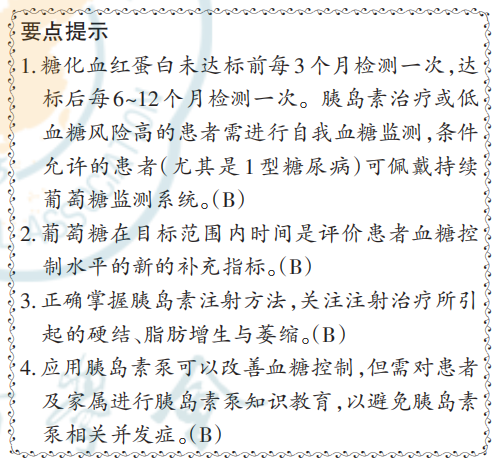
一、血糖监测
血糖监测技术包括自我血糖监测、CCM、糖化白蛋白和HbA1c等。
HbA1c是临床上用以评价长期血糖控制状况的金标准,是调整治疗方案的重要依据。对于HbA.未达标的患者,建议每3个月检测一次。一旦达标后,可每6~12个月检测一次。但 HbA,也存在一定的局限性,如难以反映血糖波动,无法捕捉低血糖事件等。建议胰岛素治疗的老年糖尿病患者进行自我血糖监测,基本监测点为空腹和三餐前,以了解患者的血糖基线水平,如患者存在夜间低血糖风险,建议根据情况加测睡前和夜间血糖,对于口服降糖药治疗且血糖控制平稳的患者无需频繁监测血糖。
在老年糖尿病患者中,佩戴 CGM 能进一步改善HbA1c,同时降低血糖变异性,而不增加低血糖风险[321‑322] 。T1DM 患者胰岛功能差、血糖波动大,更可能从CGM中获益。建议临床医师结合患者的血糖情况、认知水平、行动能力、经济情况等进行综合评估后提出是否佩戴CGM的建议。在使用基础胰岛素的老年T2DM患者中,使用CGM的患者较传统指血检测的患者 TIR 增加,其获益与年轻患者一致[323] 。
TIR 是指 24 h 内葡萄糖在目标范围的时长或所占的百分比,成人糖尿病患者中TIR的血糖范围一般界定为3.9~10.0 mmol/L,但尚缺乏针对老年糖尿病患者的研究。近年来国际共识推荐 TIR 可作为成人 T1DM 和 T2DM 血糖控制情况的评价指标,同时 TBR和 TAR也可以作为评价治疗方案的有效参数。我国的研究表明,在 T2DM 中 TIR 独立于HbA1c与糖尿病微血管并发症相关(患者平均年龄60.4岁)[324] ,与心血管死亡、全因死亡相关(患者平均年龄 61.7 岁)[325] 。在老年糖尿病的管理中,TIR也可以作为评价血糖控制水平的补充指标,但尚需针对老年糖尿病患者的研究证实。TIR 目标的确定需考虑老年糖尿病患者的个体化差异和低血糖风险,并有待进一步的循证医学证据明确。研究显示,在 T1DM 中 TIR 与 TAR 相关性强,但与 TBR 相关性弱,对于使用自动胰岛素给药系统的老年患者,应优先考虑降低 TBR 以减少低血糖风险[326] 。除了影响血糖控制外,CGM 对老年糖尿病还具有其他获益,例如患者可以与家人或其他照护者持续分享血糖结果;减少指血血糖检测次数,尤其是对于有身体残疾、认知障碍或视力障碍的患者;对于低血糖觉察能力降低或受损的患者,CGM 可以帮助患者觉察低血糖[327] 。
二、注射技术
正确的皮下胰岛素注射技术包括每次注射后更换针头、选择合适的部位注射、轮换注射的部位、适当护理注射部位以及避免肌肉注射。推荐注射部位包括腹部、大腿、臀部和上臂。长期在同一部位进行 注射可能导致局部脂肪肥大或脂肪萎缩[328],需定期并轮替变换注射部位 。 中国 ITIMPROVE 研究对中国糖尿病患者、医师和护士的问卷调查显示,34.7% 患者出现注射部位脂肪增生,针头重复使用以及注射部位轮换不当可分别使脂肪增生风险增加 3.15 倍和 1.27 倍,同时也增加HbA1c达标的风险[329] 。
老年糖尿病患者如果存在痴呆、视力丧失、神经病变、活动能力差、手指灵活性差等情况,在进行胰岛素注射时出现遗漏注射、错误注射的风险增加,医师也无法准确了解患者胰岛素的实际注射情况。随着胰岛素注射笔的不断改良,更多的功能已被开发并应用。记忆功能可记录上次胰岛素注射的剂量和注射时间,帮助提高胰岛素治疗的依从性[330] 。依托具有可连接功能、支持近距离无线通信的手机等智能设备进行连接,可以将胰岛素注射记录传输到智能手机等设备并通过应用程序生成可视化注册日志并分享。一项前瞻性临床研究提示,可连接胰岛素笔能显著减少43%的胰岛素注射遗漏,提高TIR,降低TAR和TBR[331] 。
无针注射技术是《中国糖尿病药物注射技术指南》推荐的注射方法之一,能缓解患者对传统有针注射笔的恐针心理,降低注射痛感,从而提高患者依从性,改善血糖控制[332] 。此外,无针注射可减少有针注射相关的不良反应,如皮下硬结、脂肪增生或萎缩,并减少了胰岛素的用量。有条件时可用于健康状态为良好(Group 1)和中等(Group 2)的老年糖尿病患者。但无针注射的操作相较于胰岛素笔注射复杂,需经专业人员指导,熟练掌握操作方法后方可自行注射。对于无法自行完成注射操作的患者,需教育患者家属积极协助或选用其他的注射方式。
三、胰岛素泵
胰岛素泵是采用人工智能控制的胰岛素输送装置,可以连续进行皮下胰岛素注射,最大程度模拟胰岛素的生理分泌,以帮助管理血糖。对于老年糖尿病患者,尤其是 T1DM,如采用多针胰岛素皮下注射治疗血糖波动大、低血糖风险高,建议试用胰岛素泵。采用多针胰岛素皮下注射难以精确调整胰岛素用量的患者也可考虑应用胰岛素泵。在老年 T2DM 患者中,有研究提示,相较于多针胰岛素皮下注射,使用胰岛素泵可以有效控制血糖,安全性和患者满意度良好[333] 。有研究证实在平均年龄大于 60 岁的 T2DM 患者中应用自动胰岛素输注系统的安全性和有效性[334] 。认知能力下降、视力下降、手指灵活性下降、无他人协助、缺乏胰岛素泵的知识等均可能是老年糖尿病患者使用胰岛素泵的限制因素[335] 。临床医师需结合患者的个体情况决定是否采用胰岛素泵治疗,并对患者及家属进行胰岛素泵知识的充分教育,包括胰岛素泵的设置、报警的处理、潜在的并发症等。应建立良好的协助模式,在患者的胰岛素泵需要调整时能被快速有效地处理,以免出现胰岛素泵相关的急性不良事件。
第十七章 老年糖尿病与中医药学
糖尿病属中医“消渴病”范畴,我国传统医学治疗历史由来已久。中医认为,糖尿病的基本病机为阴虚燥热,因具有口干多饮、多食易饥、小便频数的临床特点,分别涉及肺、胃、肾等病位,其治疗相应可分上、中、下三消论治。中医药在糖尿病及其并发症的治疗中有一定效果。由于老年患者常伴器官功能衰退,多种并发症和合并症并存,中西药物使用情况复杂等多重因素,因此,需要在专业中医指导下接受中医、中西医结合治疗,并且在治疗过程中注意用药的安全性。
执笔者:
潘 琦(北京医院内分泌科 国家老年医学中心)
邓明群(北京医院内分泌科 国家老年医学中心)
虞睿琪(中国医学科学院北京协和医院内分泌科)
专家委员会名单(按照姓氏拼音排序):
陈 宏(南方医科大学珠江医院内分泌科)
陈 丽(山东大学齐鲁医院内分泌科)
陈莉明(天津医科大学朱宪彝纪念医院内分泌科)
陈有信(中国医学科学院北京协和医院眼科)
窦京涛(解放军总医院第一医学中心内分泌科)
杜建玲(大连医科大学附属第一医院内分泌科)
段滨红(黑龙江省医院内分泌科)
郭立新(北京医院内分泌科 国家老年医学中心)
洪天配(北京大学第三医院内分泌科)
侯新国(山东大学齐鲁医院内分泌科)
胡 吉(苏州大学附属第二医院内分泌科)
姬秋和(空军军医大学西京医院内分泌科)
纪立农(北京大学人民医院内分泌科)
姜 昕(深圳市人民医院老年病科)
蒋 升(新疆医科大学第一附属医院内分泌科)
康 琳(中国医学科学院北京协和医院老年医学科)
匡洪宇(哈尔滨医科大学附属第一医院内分泌科)
邝 建(广东省人民医院内分泌科)
雷闽湘(中南大学湘雅医院内分泌科)
李春霖(解放军总医院第二医学中心内分泌科)
李全民(火箭军特色医学中心内分泌科)
李 兴(山西医科大学第二医院内分泌科)
李延峰(中国医学科学院北京协和医院神经内科)
李益明(复旦大学附属华山医院内分泌科)
李 勇(复旦大学附属华山医院心血管内科)
梁瑜祯(广西医科大学第二附属医院内分泌科)
林夏鸿(中山大学附属第七医院内分泌科)
刘 静(甘肃省人民医院内分泌科)
刘幼硕(中南大学湘雅二医院老年医学科)
鹿 斌(复旦大学附属华东医院内分泌科)
陆颖理(上海交通大学医学院附属第九人民医院内分泌科)
吕文山(青岛大学附属医院内分泌科)
母义明(解放军总医院第一医学中心内分泌科)
潘 琦(北京医院内分泌科 国家老年医学中心)
秦贵军(郑州大学第一附属医院内分泌科)
沈云峰(南昌大学第二附属医院内分泌科)
施 红(北京医院老年医学科 国家老年医学中心)
宋光耀(河北省人民医院内分泌科)
童南伟(四川大学华西医院内分泌科)
王建业(北京医院泌尿外科 国家老年医学中心 中国医学科学院老
年医学研究院)
王世东(北京中医药大学东直门医院内分泌科)
王颜刚(青岛大学附属医院内分泌科)
王正珍(北京体育大学运动医学与康复学院)
吴 静(中南大学湘雅医院内分泌科)
吴天凤(浙江医院内分泌科)
武晓泓(浙江省人民医院内分泌科)
肖建中(清华大学附属北京清华长庚医院内分泌科)
肖新华(中国医学科学院北京协和医院内分泌科)
谢晓敏(银川市第一人民医院内分泌科)
徐 静(西安交通大学第二附属医院内分泌科)
徐向进(解放军联勤保障部队第九〇〇医院内分泌科)
徐焱成(武汉大学中南医院内分泌科)
徐 勇(西南医科大学附属医院内分泌科)
徐玉善(昆明医科大学第一附属医院内分泌科)
许樟荣(解放军战略支援部队特色医学中心内分泌科)
薛耀明(南方医科大学第一临床医学院南方医院内分泌科)
杨 川(中山大学孙逸仙纪念医院内分泌科)
杨 静(山西医科大学第一医院内分泌科)
杨 涛(南京医科大学第一附属医院内分泌科)
杨 莹(云南大学附属医院内分泌科)
余学锋(华中科技大学同济医学院附属同济医院内分泌科)
袁慧娟(河南省人民医院内分泌科)
张 波(中日友好医院内分泌科)
张存泰(华中科技大学同济医学院附属同济医院老年医学科)
张俊清(北京大学第一医院内分泌科)
章 秋(安徽医科大学第一附属医院内分泌科)
赵家军(山东第一医科大学附属省立医院内分泌科)
利益冲突 所有作者声明无利益冲突
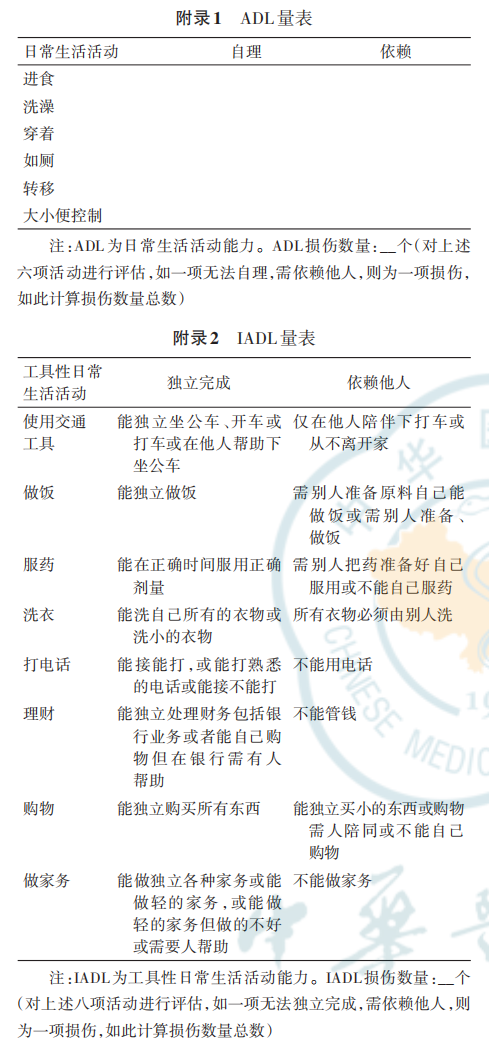
参 考 文 献
[1] 中华人民共和国民政部 . 2021 年民政事业发展统计公报 [EB/OL]. (2022‑08‑26) [2023‑11‑01]. https://www. mca.gov.cn/n156/n189/index.html.
[2] LeRoith D, Biessels GJ, Braithwaite SS, et al. Treatment of diabetes in older adults: an Endocrine Society* clinical practice guideline[J]. J Clin Endocrinol Metab, 2019,
104(5):1520‑1574. DOI: 10.1210/jc.2019‑00198.
[3] 国务院办公厅 . 中国防治慢性病中长期规划(2017—2025 年) [EB/OL]. (2017‑02‑14) [2023‑11‑01]. https://www.forestry.gov.cn/c/www/gwywj/56699.jhtml.
[4] 国家老年医学中心, 中华医学会老年医学分会, 中国老年保健协会糖尿病专业委员会 . 中国老年糖尿病诊疗指南(2021 年版)[J]. 中华糖尿病杂志, 2021, 13(1):14‑46. DOI:10.3760/cma.j.cn115791‑20201209‑00707.
[5] 中国老年 2型糖尿病防治临床指南编写组, 中国老年医学学会老年内分泌代谢分会, 中国老年保健医学研究会老年内分泌与代谢分会, 等. 中国老年2型糖尿病防治临床指南(2022 年版) [J]. 中华内科杂志, 2022, 61(1):12‑50. DOI:10.3760/cma.j.cn112138‑20211027‑00751.
[6] Wang L, Peng W, Zhao Z, et al. Prevalence and treatment of diabetes in China, 2013—2018[J]. JAMA, 2021, 326(24):2498‑2506. DOI: 10.1001/jama.2021.22208.
[7] Sinclair A, Saeedi P, Kaundal A, et al. Diabetes and global ageing among 65‑99‑year‑old adults: findings from the International Diabetes Federation Diabetes Atlas, 9(th) edition[J]. Diabetes Res Clin Pract, 2020, 162: 108078. DOI: 10.1016/j.diabres.2020.108078.
[8] Li Y, Teng D, Shi X, et al. Prevalence of diabetes recorded in mainland China using 2018 diagnostic criteria from the American Diabetes Association: national cross sectional study[J]. BMJ, 2020, 369:m997. DOI: 10.1136/bmj.m997.
[9] Bragg F, Holmes MV, Iona A, et al. Association between diabetes and cause‑specific mortality in rural and urban areas of China[J]. JAMA, 2017, 317(3): 280‑289. DOI: 10.1001/jama.2016.19720.
[10] Barnett KN, McMurdo ME, Ogston SA, et al. Mortality in people diagnosed with type 2 diabetes at an older age: a systematic review[J]. Age Ageing, 2006, 35(5): 463‑468. DOI: 10.1093/ageing/afl019.
[11] Ji L, Hu D, Pan C, et al. Primacy of the 3B approach to control risk factors for cardiovascular disease in type 2 diabetes patients[J]. Am J Med, 2013, 126(10): 925. e11‑e22. DOI: 10.1016/j.amjmed.2013.02.035.
[12] World Health Organization. Use of glycated haemoglobin (HbA1c) in the diagnosis of diabetes mellitus: abbreviated report of a WHO consultation[M]. Geneva: World Health Organization, 2011.
[13] Picón MJ, Murri M, Muñoz A, et al. Hemoglobin A1c versus oral glucose tolerance test in postpartum diabetes screening[J]. Diabetes Care, 2012, 35(8):1648‑1653. DOI: 10.2337/dc11‑2111.
[14] Huang SH, Huang PJ, Li JY, et al. Hemoglobin A1c levels associated with age and gender in Taiwanese adults without prior diagnosis with diabetes[J]. Int J Environ Res Public Health, 2021, 18(7): 3390. DOI: 10.3390/
[15] Lin L, Wang A, He Y, et al. Effects of the hemoglobin glycation index on hyperglycemia diagnosis: results from the REACTION study[J]. Diabetes Res Clin Pract, 2021, 180:109039. DOI: 10.1016/j.diabres.2021.109039.
[16] Kotwal A, Haddox C, Block M, et al. Immune checkpoint inhibitors: an emerging cause of insulin‑dependent diabetes[J]. BMJ Open Diabetes Res Care, 2019, 7(1): e000591. DOI: 10.1136/bmjdrc‑2018‑000591.
[17] Aggarwal G, Kamada P, Chari ST. Prevalence of diabetes mellitus in pancreatic cancer compared to common cancers[J]. Pancreas, 2013, 42(2):198‑201. DOI: 10.1097/ MPA.0b013e3182592c96.
[18] Andersen DK, Korc M, Petersen GM, et al. Diabetes, pancreatogenic diabetes, and pancreatic cancer[J]. Diabetes, 2017, 66(5): 1103‑1110. DOI: 10.2337/ db16‑1477.
[19] Crandall JP, Mather K, Rajpathak SN, et al. Statin use and risk of developing diabetes: results from the Diabetes Prevention Program[J]. BMJ Open Diabetes Res Care, 2017, 5(1):e000438. DOI: 10.1136/bmjdrc‑2017‑000438.
[20] 胡秀英, 龙纳, 吴琳娜, 等 . 中国老年人健康综合功能评价量表的研制 [J]. 四川大学学报 ( 医学版), 2013, 44(4): 610‑613.
[21] 樊瑾, 于普林, 李小鹰 . 中国健康老年人标准(2013)解读2——健康评估方法[J]. 中华老年医学杂志, 2014, 33(1): 1‑3. DOI: 10.3760/cma.j.issn.0254‑9026.2014.01.001.
[22] 茅范贞, 陈俊泽, 苏彩秀, 等 . 老年健康功能多维评定量表的研制[J].中国卫生统计, 2015, 32(3):379‑382.
[23] Katz SC, Ford AB, Moskowitz RW, et al. Studies of illness in the aged. The index of Adl: a standardized measure of biological and psychosocial function[J]. JAMA, 1963, 185(12): 914‑919. DOI: 10.1001/jama.1963.03060120024016.
[24] Lawton MP, Brody EM. Assessment of older people: self‑maintaining and instrumental activities of daily living [J]. Gerontologist, 1969, 9(3):179‑186.
[25] Liu Y, Xiao X, Peng C, et al. Development and implementation of couple‑based collaborative management model of type 2 diabetes mellitus for community‑dwelling Chinese older adults: a pilot randomized trial[J]. Front Public Health, 2021, 9:686282. DOI: 10.3389/fpubh.2021.686282.
[26] Li F, Guo S, Gong W, et al. Self‑management of diabetes for empty nest older adults: a randomized controlled trial[J]. West J Nurs Res, 2023, 45(10): 921‑931. DOI: 10.1177/01939459231191599.
[27] Sng GGR, Tung JYM, Lim DYZ, et al. Potential and pitfalls of ChatGPT and natural‑language artificial intelligence models for diabetes education[J]. Diabetes Care, 2023, 46(5):e103‑e105. DOI: 10.2337/dc23‑0197.
[28] Battelino T, Danne T, Bergenstal RM, et al. Clinical targets for continuous glucose monitoring data interpretation: recommendations from the international consensus on time in range[J]. 2019, 42(8):1593‑1603.
[29] American Diabetes Association. (6) Glycemic targets[J]. Diabetes Care, 2015, 38 Suppl: S33‑S40. DOI: 10.2337/ dc15‑S009.
[30] Rahi B, Morais JA, Gaudreau P, et al. Energy and protein intakes and their association with a decline in functional capacity among diabetic older adults from the NuAge cohort[J]. Eur J Nutr, 2016, 55(4): 1729‑1739. DOI: 10.1007/s00394‑015‑0991‑1.
[31] Op den Kamp CM, Langen RC, Haegens A, et al. Muscle atrophy in cachexia: can dietary protein tip the balance? [J]. Curr Opin Clin Nutr Metab Care, 2009, 12(6):611‑616. DOI: 10.1097/MCO.0b013e3283319399.
[32] Markova M, Pivovarova O, Hornemann S, et al. Isocaloric diets high in animal or plant protein reduce liver fat and inflammation in individuals with type 2 diabetes[J]. Gastroenterology, 2017, 152(3): 571‑585. e8. DOI: 10.1053/j.gastro.2016.10.007.
[33] Shukla AP, Dickison M, Coughlin N, et al. The impact of food order on postprandial glycaemic excursions in prediabetes[J]. Diabetes Obes Metab, 2019, 21(2): 377‑381. DOI: 10.1111/dom.13503.
[34] Turnbull PJ, Sinclair AJ. Evaluation of nutritional status and its relationship with functional status in older citizens with diabetes mellitus using the mini nutritional assessment (MNA) tool‑‑a preliminary investigation[J]. J Nutr Health Aging, 2002, 6(3):185‑189.
[35] Tan S, Li W, Wang J. Effects of six months of combined aerobic and resistance training for elderly patients with a long history of type 2 diabetes[J]. J Sports Sci Med, 2012, 11(3):495‑501.
[36] Lu X, Zhao C. Exercise and type 1 diabetes[J]. Adv Exp Med Biol, 2020, 1228: 107‑121. DOI: 10.1007/978‑981‑15‑1792‑1_7.
[37] Sampath Kumar A, Maiya AG, Shastry BA, et al. Exercise and insulin resistance in type 2 diabetes mellitus: a systematic review and meta‑analysis[J]. Ann Phys Rehabil Med, 2019, 62(2): 98‑103. DOI:
10.1016/j. rehab.2018.11.001.
[38] Dunstan DW, Daly RM, Owen N, et al. High‑intensity resistance training improves glycemic control in older patients with type 2 diabetes[J]. Diabetes Care, 2002, 25(10):1729‑1736. DOI: 10.2337/diacare.25.10.1729.
[39] Jansson AK, Chan LX, Lubans DR, et al. Effect of resistance training on HbA1c in adults with type 2 diabetes mellitus and the moderating effect of changes in muscular strength: a systematic review and meta‑analysis[J]. BMJ Open Diabetes Res Care, 2022, 10(2): e002595. DOI: 10.1136/bmjdrc‑2021‑002595.
[40] Morrison S, Colberg SR, Mariano M, et al. Balance training reduces falls risk in older individuals with type 2 diabetes [J]. Diabetes Care, 2010, 33(4): 748‑750. DOI: 10.2337/ dc09‑1699.
[41] Wang Y, Yan J, Zhang P, et al. Tai Chi Program to improve glucose control and quality of life for the elderly with type 2 diabetes: a Meta‑analysis[J]. Inquiry, 2022, 59: 469580211067934. DOI: 10.1177/00469580211067934.
[42] Chodzko‑Zajko WJ, Proctor DN, Fiatarone Singh MA, et al. American College of Sports Medicine position stand. Exercise and physical activity for older adults[J]. Med Sci Sports Exerc, 2009, 41(7): 1510‑1530. DOI: 10.1249/ MSS.0b013e3181a0c95c.
[43] Kanaley JA, Colberg SR, Corcoran MH, et al. Exercise/physical activity in individuals with type 2 diabetes: a consensus statement from the American College of Sports Medicine[J]. Med Sci Sports Exerc, 2022, 54(2):353‑368. DOI: 10.1249/MSS.0000000000002800.
[44] Blonde L, Dailey GE, Jabbour SA, et al. Gastrointestinal tolerability of extended‑release metformin tablets compared to immediate‑release metformin tablets: results of a retrospective cohort study[J]. Curr Med Res Opin, 2004, 20(4):565‑572. DOI: 10.1185/030079904125003278.
[45] 二甲双胍临床应用专家共识 (2018 年 版)[J]. 中国糖尿病杂志 , 2019, 27(3): 161‑173. DOI: 10.3969/j. issn.1006‑6187.2019.03.001.
[46] Wong CW, Leung CS, Leung CP, et al. Association of metformin use with vitamin B(12) deficiency in the institutionalized elderly[J]. Arch Gerontol Geriatr, 2018, 79:57‑62. DOI: 10.1016/j.archger.2018.07.019.
[47] American Diabetes Association Professional Practice Committee. 13. Older adults: standards of care in diabetes —2024[J]. Diabetes Care, 2024, 47(Suppl 1): S244‑S257. DOI: 10.2337/dc24‑S013.
[48] 叶林虎, 贺梅, 赵欣黔, 等. 磺脲类降糖药的潜在药物相互作用研究进展[J].中国医院药学杂志, 2018, 38(12):1333‑1337. DOI: 10.13286/j.cnki.chinhosppharmacyj.2018.12.21.
[49] 中华医学会糖尿病学分会 . 中国 2 型糖尿病防治指南 (2020 年版) [J]. 中华糖尿病杂志, 2021, 13(4):315‑409. DOI: 10.3760/cma.j.cn115791‑20210221‑00095.
[50] Zhang J, Guo L. Effectiveness of acarbose in treating elderly patients with diabetes with postprandial hypotension[J]. J Investig Med, 2017, 65(4):772‑783. DOI: 10.1136/jim‑2016‑000295.
[51] Dormandy JA, Charbonnel B, Eckland DJ, et al. Secondary prevention of macrovascular events in patients with type 2 diabetes in the PROactive Study (PROspective pioglitAzone Clinical Trial In macroVascular Events): a randomised controlled trial[J]. Lancet, 2005, 366(9493): 1279‑1289. DOI: 10.1016/S0140‑6736(05)67528‑9.
[52] Lee M, Saver JL, Liao HW, et al. Pioglitazone for secondary stroke prevention: a systematic review and Meta‑analysis [J]. Stroke, 2017, 48(2): 388‑393. DOI: 10.1161/ STROKEAHA.116.013977.
[53] Yen CL, Wu CY, Tsai CY, et al. Pioglitazone reduces cardiovascular events and dementia but increases bone fracture in elderly patients with type 2 diabetes mellitus: a national cohort study[J]. Aging (Albany NY), 2023, 15(7):2721‑2733. DOI: 10.18632/aging.204643.
[54] Phatak HM, Yin DD. Factors associated with the effect‑size of thiazolidinedione (TZD) therapy on HbA(1c): a meta‑analysis of published randomized clinical trials[J]. Curr Med Res Opin, 2006, 22(11): 2267‑2278. DOI: 10.1185/030079906X148328.
[55] Schwartz AV, Chen H, Ambrosius WT, et al. Effects of TZD use and discontinuation on fracture rates in ACCORD bone study[J]. J Clin Endocrinol Metab, 2015, 100(11): 4059‑4066. DOI: 10.1210/jc.2015‑1215.
[56] Billington EO, Grey A, Bolland MJ. The effect of thiazolidinediones on bone mineral density and bone turnover: systematic review and meta‑analysis[J]. Diabetologia, 2015, 58(10): 2238‑2246. DOI: 10.1007/ s00125‑015‑3660‑2.
[57] Mulvihill EE, Drucker DJ. Pharmacology, physiology, and mechanisms of action of dipeptidyl peptidase‑4 inhibitors [J]. Endocr Rev, 2014, 35(6): 992‑1019. DOI: 10.1210/ er.2014‑1035.
[58] Scheen AJ. The safety of gliptins: updated data in 2018[J]. Expert Opin Drug Saf, 2018, 17(4): 387‑405. DOI:10.1080/14740338.2018.1444027.
[59] Stafford S, Elahi D, Meneilly GS. Effect of the dipeptidyl peptidase‑4 inhibitor sitagliptin in older adults with type 2 diabetes mellitus[J]. J Am Geriatr Soc, 2011, 59(6): 1148‑1149. DOI: 10.1111/j.1532‑5415.2011.03438.x.
[60] Ledesma G, Umpierrez GE, Morley JE, et al. Efficacy and safety of linagliptin to improve glucose control in older people with type 2 diabetes on stable insulin therapy: a randomized trial[J]. Diabetes Obes Metab, 2019, 21(11): 2465‑2473. DOI: 10.1111/dom.13829.
[61] Bethel MA, Engel SS, Green JB, et al. Assessing the safety of sitagliptin in older participants in the trial evaluating cardiovascular outcomes with sitagliptin (TECOS) [J]. Diabetes Care, 2017, 40(4): 494‑501. DOI: 10.2337/ dc16‑1135.
[62] Cooper ME, Rosenstock J, Kadowaki T, et al. Cardiovascular and kidney outcomes of linagliptin treatment in older people with type 2 diabetes and established cardiovascular disease and/or kidney disease: a prespecified subgroup analysis of the randomized, placebo‑controlled CARMELINA® trial[J]. Diabetes Obes Metab, 2020, 22(7): 1062‑1073. DOI: 10.1111/dom.13995.
[63] Leiter LA, Teoh H, Braunwald E, et al. Efficacy and safety of saxagliptin in older participants in the SAVOR‑TIMI 53 trial[J]. Diabetes Care, 2015, 38(6): 1145‑1153. DOI: 10.2337/dc14‑2868.
[64] Gallo LA, Wright EM, Vallon V. Probing SGLT2 as a therapeutic target for diabetes: basic physiology and consequences[J]. Diab Vasc Dis Res, 2015, 12(2): 78‑89. DOI: 10.1177/1479164114561992.
[65] Lunati ME, Cimino V, Gandolfi A, et al. SGLT2‑inhibitors are effective and safe in the elderly: the SOLD study[J]. Pharmacol Res, 2022, 183: 106396. DOI: 10.1016/j. phrs.2022.106396.
[66] Tahrani AA, Barnett AH, Bailey CJ. SGLT inhibitors in management of diabetes[J]. Lancet Diabetes Endocrinol, 2013, 1(2): 140‑151. DOI: 10.1016/S2213‑8587(13) 70050‑0.
[67] Wiviott SD, Raz I, Bonaca MP, et al. Dapagliflozin and cardiovascular outcomes in type 2 diabetes[J]. N Engl J Med, 2019, 380(4): 347‑357. DOI: 10.1056/
[68] Neal B, Perkovic V, Mahaffey KW, et al. Canagliflozin and cardiovascular and renal events in type 2 diabetes[J]. N Engl J Med, 2017, 377(7): 644‑657. DOI: 10.1056/
[69] Zinman B, Wanner C, Lachin JM, et al. Empagliflozin, cardiovascular outcomes, and mortality in type 2 diabetes [J]. N Engl J Med, 2015, 373(22): 2117‑2128. DOI: 10.1056/NEJMoa1504720.
[70] Cannon CP, Pratley R, Dagogo‑Jack S, et al. Cardiovascular outcomes with ertugliflozin in type 2 diabetes[J]. N Engl J Med, 2020, 383(15): 1425‑1435. DOI: 10.1056/
[71] Ji L, Ma J, Li H, et al. Dapagliflozin as monotherapy in drug‑naive Asian patients with type 2 diabetes mellitus: a randomized, blinded, prospective phase Ⅲ study[J]. Clin Ther, 2014, 36(1): 84‑100. e9. DOI: 10.1016/j. clinthera.2013.11.002.
[72] Yabe D, Shiki K, Homma G, et al. Efficacy and safety of the sodium‑glucose co‑transporter‑2 inhibitor empagliflozin in elderly Japanese adults (≥65 years) with type 2 diabetes: a randomized, double‑blind, placebo‑controlled, 52‑week clinical trial (EMPA‑ELDERLY)[J]. Diabetes Obes Metab, 2023, 25(12): 3538‑3548. DOI: 10.1111/ dom.15249.
[73] Karagiannis T, Tsapas A, Athanasiadou E, et al. GLP‑1 receptor agonists and SGLT2 inhibitors for older people with type 2 diabetes: a systematic review and meta‑analysis[J]. Diabetes Res Clin Pract, 2021, 174: 108737. DOI: 10.1016/j.diabres.2021.108737.
[74] Monteiro P, Bergenstal RM, Toural E, et al. Efficacy and safety of empagliflozin in older patients in the EMPA‑REG OUTCOME® trial[J]. Age Ageing, 2019, 48(6): 859‑866. DOI: 10.1093/ageing/afz096.
[75] Mahaffey KW, Neal B, Perkovic V, et al. Canagliflozin for primary and secondary prevention of cardiovascular events: results from the CANVAS program (Canagliflozin Cardiovascular Assessment Study) [J]. Circulation, 2018, 137(4): 323‑334. DOI: 10.1161/ CIRCULATIONAHA.117.032038.
[76] Cahn A, Mosenzon O, Wiviott SD, et al. Efficacy and safety of dapagliflozin in the elderly: analysis from the DECLARE‑TIMI 58 Study[J]. Diabetes Care, 2020, 43(2): 468‑475. DOI: 10.2337/dc19‑1476.
[77] Perkovic V, Jardine MJ, Neal B, et al. Canagliflozin and renal outcomes in type 2 diabetes and nephropathy[J]. N Engl J Med, 2019, 380(24): 2295‑2306. DOI: 10.1056/NEJMoa1811744.
[78] Mosenzon O, Wiviott SD, Cahn A, et al. Effects of dapagliflozin on development and progression of kidney disease in patients with type 2 diabetes: an analysis from the DECLARE‑TIMI 58 randomised trial[J]. Lancet Diabetes Endocrinol, 2019, 7(8):606‑617. DOI: 10.1016/ S2213‑8587(19)30180‑9.
[79] Wanner C, Inzucchi SE, Lachin JM, et al. Empagliflozin and progression of kidney disease in type 2 diabetes[J]. N Engl J Med, 2016, 375(4): 323‑334. DOI: 10.1056/
[80] The EMPA‑KIDNEY Collaborative Group, Herrington WG, Staplin N, et al. Empagliflozin in patients with chronic kidney disease[J]. N Engl J Med. 2023, 388(2): 117‑127. DOI: 10.1056/NEJMoa2204233.
[81] Heerspink HJL, Stefánsson BV, Correa‑Rotter R, et al. Dapagliflozin in patients with chronic kidney disease[J]. N Engl J Med, 2020, 383(15): 1436‑1446. DOI: 10.1056/
[82] Heerspink HJL, Sjöström CD, Jongs N, et al. Effects of dapagliflozin on mortality in patients with chronic kidney disease: a pre‑specified analysis from the DAPA‑CKD randomized controlled trial[J]. Eur Heart J, 2021, 42(13): 1216‑1227. DOI: 10.1093/eurheartj/ehab094.
[83] Böhm M, Butler J, Filippatos G, et al. Empagliflozin improves outcomes in patients with heart failure and preserved ejection fraction irrespective of age[J]. J Am Coll Cardiol, 2022, 80(1): 1‑18. DOI: 10.1016/j. jacc.2022.04.040.
[84] Anker SD, Butler J, Filippatos G, et al. Empagliflozin in heart failure with a preserved ejection fraction[J]. N Engl J Med, 2021, 385(16): 1451‑1461. DOI: 10.1056/
[85] Packer M, Anker SD, Butler J, et al. Cardiovascular and renal outcomes with empagliflozin in heart failure[J]. N Engl J Med, 2020, 383(15): 1413‑1424. DOI: 10.1056/
[86] McMurray JJV, Solomon SD, Inzucchi SE, et al. Dapagliflozin in patients with heart failure and reduced ejection fraction[J]. N Engl J Med, 2019, 381(21): 1995‑2008. DOI: 10.1056/NEJMoa1911303.
[87] Peikert A, Martinez FA, Vaduganathan M, et al. Efficacy and safety of dapagliflozin in heart failure with mildly reduced or preserved ejection fraction according to age: the DELIVER Trial[J]. Circ Heart Fail, 2022, 15(10):e010080. DOI: 10.1161/ CIRCHEARTFAILURE.122.010080.
[88] Solomon SD, McMurray J, Claggett B, et al. Dapagliflozin in heart failure with mildly reduced or preserved ejection fraction[J]. N Engl J Med, 2022, 387(12):1089‑1098. DOI: 10.1056/NEJMoa2206286.
[89] Pratley RE, Cannon CP, Cherney DZI, et al. Cardiorenal outcomes, kidney function, and other safety outcomes with ertugliflozin in older adults with type 2 diabetes (VERTIS CV): secondary analyses from a randomised, double‑blind trial[J]. Lancet Healthy Longev, 2023, 4(4): e143‑e154. DOI: 10.1016/S2666‑7568(23)00032‑6.
[90] 孔德华, 李敬文, 周红 . 钠‑葡萄糖共转运蛋白 2 抑制剂对 2型糖尿病患者酮症酸中毒影响的Meta分析[J]. 中华糖尿病杂志 , 2023, 15(2): 144‑151. DOI: 10.3760/cma. j. cn115791‑20220409‑00148.
[91] Kidney Disease: Improving Global Outcomes (KDIGO) Diabetes Work Group. KDIGO 2022 clinical practice guideline for diabetes management in chronic kidney disease[J]. Kidney Int, 2022, 102(5S): S1‑S127. DOI: 10.1016/j.kint.2022.06.008.
[92] Madsbad S. Review of head‑to‑head comparisons of glucagon‑like peptide‑1 receptor agonists[J]. Diabetes Obes Metab, 2016, 18(4): 317‑332. DOI: 10.1111/ dom.12596.
[93] Singh S, Wright EE Jr, Kwan AY, et al. Glucagon‑like peptide‑1 receptor agonists compared with basal insulins for the treatment of type 2 diabetes mellitus: a systematic review and meta‑analysis[J]. Diabetes Obes Metab, 2017, 19(2):228‑238. DOI: 10.1111/dom.12805.
[94] Htike ZZ, Zaccardi F, Papamargaritis D, et al. Efficacy and safety of glucagon‑like peptide‑1 receptor agonists in type 2 diabetes: a systematic review and mixed‑treatment comparison analysis[J]. Diabetes Obes Metab, 2017, 19(4):524‑536. DOI: 10.1111/dom.12849.
[95] Hamano K, Nishiyama H, Matsui A, et al. Efficacy and safety analyses across 4 subgroups combining low and high age and body mass index groups in Japanese phase 3 studies of dulaglutide 0.75 mg after 26 weeks of treatment[J]. Endocr J, 2017, 64(4): 449‑456. DOI:
10.1507/endocrj.EJ16‑0428. [96] Raccah D, Miossec P, Esposito V, et al. Efficacy and safety of lixisenatide in elderly (≥65 years old) and very elderly (≥75 years old) patients with type 2 diabetes : an analysis from the GetGoal phase Ⅲ programme[J]. Diabetes Metab Res Rev, 2015, 31(2):204 ‑ 211. DOI: 10.1002/dmrr.2588.
[97] Bode BW, Brett J, Falahati A, et al. Comparison of the efficacy and tolerability profile of liraglutide, a once‑daily human GLP‑1 analog, in patients with type 2 diabetes≥65 and<65 years of age: a pooled analysis from phase Ⅲ studies[J]. Am J Geriatr Pharmacother, 2011, 9(6): 423‑433. DOI: 10.1016/j.amjopharm.2011.09.007.
[98] Kristensen SL, Rørth R, Jhund PS, et al. Cardiovascular, mortality, and kidney outcomes with GLP‑1 receptor agonists in patients with type 2 diabetes: a systematic review and meta‑analysis of cardiovascular outcome trials [J]. Lancet Diabetes Endocrinol, 2019, 7(10): 776‑785.DOI: 10.1016/S2213‑8587(19)30249‑9.
[99] Gerstein HC, Colhoun HM, Dagenais GR, et al. Dulaglutide and cardiovascular outcomes in type 2 diabetes (REWIND): a double‑blind, randomised placebo‑controlled trial[J]. Lancet, 2019, 394(10193):121‑130. DOI: 10.1016/S0140‑6736(19) 31149‑3.
[100] Marso SP, Daniels GH, Brown‑Frandsen K, et al. Liraglutide and cardiovascular outcomes in type 2 diabetes[J]. N Engl J Med, 2016, 375(4): 311‑322. DOI: 10.1056/NEJMoa1603827.
[101] Marso SP, Bain SC, Consoli A, et al. Semaglutide and cardiovascular outcomes in patients with type 2 diabetes [J]. N Engl J Med, 2016, 375(19): 1834‑1844. DOI: 10.1056/NEJMoa1607141.
[102] Pfeffer MA, Claggett B, Diaz R, et al. Lixisenatide in patients with type 2 diabetes and acute coronary syndrome[J]. N Engl J Med, 2015, 373(23): 2247‑2257. DOI: 10.1056/NEJMoa1509225.
[103] Holman RR, Bethel MA, Mentz RJ, et al. Effects of once‑weekly exenatide on cardiovascular outcomes in type 2 diabetes[J]. N Engl J Med, 2017, 377(13): 1228‑1239. DOI: 10.1056/NEJMoa1612917.
[104] Li C, Luo J, Jiang M, et al. The efficacy and safety of the combination therapy with GLP‑1 receptor agonists and SGLT‑2 inhibitors in type 2 diabetes mellitus: a systematic review and Meta‑analysis[J]. Front Pharmacol, 2022, 13: 838277. DOI: 10.3389/fphar.2022.838277.
[105] Riley DR, Essa H, Austin P, et al. All‑cause mortality and cardiovascular outcomes with sodium‑glucose co‑transporter 2 inhibitors, glucagon‑like peptide‑1 receptor agonists and with combination therapy in people with type 2 diabetes[J]. Diabetes Obes Metab, 2023, 25(10):2897‑2909. DOI: 10.1111/dom.15185.
[106] Sinclair AJ, Dashora U, George S, et al. Joint British Diabetes Societies for Inpatient Care (JBDS‑IP) Clinical Guideline Inpatient care of the frail older adult with diabetes: an Executive Summary[J]. Diabet Med, 2020, 37(12):1981‑1991. DOI: 10.1111/dme.14341.
[107] Sodhi M, Rezaeianzadeh R, Kezouh A, et al. Risk of gastrointestinal adverse events associated with glucagon‑like peptide‑1 receptor agonists for weight loss [J]. JAMA, 2023, 330(18): 1795‑1797. DOI: 10.1001/ jama.2023.19574.
[108] 冉兴无,母义明,朱大龙,等.成人2型糖尿病基础胰岛素临床应用中国专家指导建议(2020版)[J]. 中国糖尿病杂志, 2020,28(10):721‑728. DOI:10.3969/j.issn.1006‑6187.2020.10.001.
[109] Blonde L, Umpierrez GE, Reddy SS, et al. American Association of Clinical Endocrinology clinical practice guideline: developing a diabetes mellitus comprehensive care plan—2022 update[J]. Endocr Pract, 2022, 28(10): 923‑1049. DOI: 10.1016/j.eprac.2022.08.002.
[110] Philis‑Tsimikas A, Astamirova K, Gupta Y, et al. Similar glycaemic control with less nocturnal hypoglycaemia in a 38‑week trial comparing the IDegAsp co‑formulation with insulin glargine U100 and insulin aspart in basal insulin‑treated subjects with type 2 diabetes mellitus[J]. Diabetes Res Clin Pract, 2019, 147: 157‑165. DOI: 10.1016/j.diabres.2018.10.024.
[111] Brunner M, Pieber T, Korsatko S, et al. The distinct prandial and basal pharmacodynamics of IDegAsp observed in younger adults are preserved in elderly subjects with type 1 diabetes[J]. Drugs Aging, 2015, 32(7): 583‑590. DOI: 10.1007/s40266‑015‑0272‑y.
[112] Fulcher G, Mehta R, Fita EG, et al. Efficacy and safety of IDegAsp versus BIAsp 30, both twice daily, in elderly patients with type 2 diabetes: post hoc analysis of two phase 3 randomized controlled BOOST trials[J]. Diabetes Ther,2019, 10(1): 107‑118. DOI: 10.1007/ s13300‑018‑0531‑0.
[113] Kaneko S, da Rocha Fernandes JD, Yamamoto Y, et al. A Japanese study assessing glycemic control with use of IDegAsp co‑formulation in patients with type 2 diabetes in clinical practice: the JAGUAR study[J]. Adv Ther, 2021, 38(3):1638‑1649. DOI: 10.1007/s12325‑021‑01623‑y.
[114] Wallia A, Molitch ME. Insulin therapy for type 2 diabetes mellitus[J]. JAMA, 2014, 311(22): 2315‑2325. DOI: 10.1001/jama.2014.5951.
[115] ElSayed NA, Aleppo G, Aroda VR, et al. 9. Pharmacologic approaches to glycemic treatment: standards of care in diabetes—2023[J]. Diabetes Care, 2023, 46(Suppl 1): S140‑S157. DOI: 10.2337/dc23‑S009.
[116] Handelsman Y, Chovanes C, Dex T, et al. Efficacy and safety of insulin glargine/lixisenatide (iGlarLixi) fixed‑ratio combination in older adults with type 2 diabetes[J]. J Diabetes Complications, 2019, 33(3): 236‑242. DOI: 10.1016/j.jdiacomp.2018.11.009.
[117] Billings LK, Agner B, Altuntas Y, et al. The benefit of insulin degludec/liraglutide (IDegLira) compared with basal‑bolus insulin therapy is consistent across participant subgroups with type 2 diabetes in the DUAL Ⅶ randomized trial [J]. J Diabetes Sci Technol, 2021, 15(3): 636‑645. DOI: 10. 1177 /1932296820906888 .
[118] 《以二甲双胍为基础的固定复方制剂治疗2型糖尿病专家共识》编写组. 以二甲双胍为基础的固定复方制剂治疗2型糖尿病专家共识[J].中华糖尿病杂志, 2022, 14(12):1380‑1386.DOI: 10.3760/cma.j.cn115791‑20220930‑00505.
[119] Bajaj HS, Ye C, Jain E, et al. Glycemic improvement with a fixed‑dose combination of DPP‑4 inhibitor + metformin in patients with type 2 diabetes (GIFT study) [J]. Diabetes Obes Metab, 2018, 20(1): 195‑199. DOI: 10.1111/ dom.13040.
[120] Rosenstock J, Aronson R, Grunberger G, et al. Benefits of lixiLan, a titratable fixed‑ratio combination of insulin glargine plus lixisenatide, versus insulin glargine and lixisenatide mono components in type 2 diabetes inadequately controlled on oral agents: the LixiLan‑O randomized trial[J]. Diabetes Care, 2016, 39(11): 2026‑2035. DOI: 10.2337/dc16‑0917.
[121] Yuan X, Guo X, Zhang J, et al. Improved glycaemic control and weight benefit with iGlarLixi versus insulin glargine 100 U/mL in Chinese people with type 2 diabetes advancing their therapy from basal insulin plus oral antihyperglycaemic drugs: results from the LixiLan‑L‑CN randomized controlled trial[J]. Diabetes Obes Metab, 2022, 24(11):2182‑2191. DOI: 10.1111/dom.14803.
[122] Blonde L, Rosenstock J, Del Prato S, et al. Switching to iGlarLixi versus continuing daily or weekly GLP‑1 RA in type 2 diabetes inadequately controlled by GLP‑1RA and oral antihyperglycemic therapy: the LixiLan‑G randomized clinical trial[J]. Diabetes Care, 2019, 42(11): 2108‑2116. DOI: 10.2337/dc19‑1357.
[123] Wang W, Agner BFR, Luo B, et al. DUAL I China: improved glycemic control with IDegLira versus its individual components in a randomized trial with Chinese participants with type 2 diabetes uncontrolled on oral antidiabetic drugs[J]. J Diabetes, 2022, 14(6): 401‑413. DOI: 10.1111/1753‑0407.13286.
[124] Pei Y, Agner BR, Luo B, et al. DUAL Ⅱ China: superior HbA1c reductions and weight loss with insulin degludec/liraglutide (IDegLira) versus insulin degludec in a randomized trial of Chinese people with type 2 diabetes inadequately controlled on basal insulin[J]. Diabetes Obes Metab, 2021, 23(12): 2687‑2696. DOI: 10.1111/dom.14522.
[125] Linjawi S, Bode BW, Chaykin LB, et al. The efficacy of IDegLira (insulin degludec/liraglutide combination) in adults with type 2 diabetes inadequately controlled with a GLP‑1 receptor agonist and oral therapy: DUAL Ⅲ randomized clinical trial[J]. Diabetes Ther, 2017, 8(1): 101‑114. DOI: 10.1007/s13300‑016‑0218‑3.
[126] Komatsu M, Watada H, Kaneko S, et al. Efficacy and safety of the fixed‑ratio combination of insulin degludec and liraglutide by baseline glycated hemoglobin, body mass index and age in Japanese individuals with type 2 diabetes: a subgroup analysis of two phase Ⅲ trials [J]. Diabetes Investig, 2021, 12(9):1610‑1618. DOI: J 1111 / jdi.13525.
[127] Zhang XH, Tian YF, Huang GL, et al. Advances in studies of Chiglitazar Sodium, a novel PPAR pan‑agonist, for the treatment of type 2 diabetes mellitus[J]. Curr Med Sci, 2023, 43(5):890‑896. DOI: 10.1007/s11596‑023‑2760‑3.
[128] Toulis KA, Nirantharakumar K, Pourzitaki C, et al. Glucokinase activators for type 2 diabetes: challenges and future developments[J]. Drugs, 2020, 80(5):467‑475. DOI: 10.1007/s40265‑020‑01278‑z.
[129] Einarson TR, Acs A, Ludwig C, et al. Prevalence of cardiovascular disease in type 2 diabetes: a systematic literature review of scientific evidence from across the world in 2007—2017[J]. Cardiovasc Diabetol, 2018, 17(1):83. DOI: 10.1186/s12933‑018‑0728‑6.
[130] Sarwar N, Gao P, Seshasai SR, et al. Diabetes mellitus, fasting blood glucose concentration, and risk of vascular disease: a collaborative meta‑analysis of 102 prospective studies[J]. Lancet, 2010, 375(9733): 2215‑2222. DOI: 10.1016/S0140‑6736(10)60484‑9.
[131] Lacey B, Lewington S, Clarke R, et al. Age‑specific association between blood pressure and vascular and non‑vascular chronic diseases in 0.5 million adults in China: a prospective cohort study[J]. Lancet Glob Health, 2018, 6(6): e641‑e649. DOI: 10.1016/S2214‑109X(18) 30217‑1.
[132] Brunström M, Carlberg B. Effect of antihypertensive treatment at different blood pressure levels in patients with diabetes mellitus: systematic review and meta‑analyses[J]. BMJ, 2016, 352:i717. DOI: 10.1136/bmj.
[133] Beckett NS, Peters R, Fletcher AE, et al. Treatment of hypertension in patients 80 years of age or older[J]. N Engl J Med, 2008, 358(18): 1887‑1898. DOI: 10.1056/
[134] Cushman WC, Evans GW, Byington RP, et al. Effects of intensive blood‑pressure control in type 2 diabetes mellitus[J]. N Engl J Med, 2010, 362(17):1575‑1585. DOI: 10.1056/NEJMoa1001286.
[135] Zhang W, Zhang S, Deng Y, et al. Trial of intensive blood‑pressure control in older patients with hypertension[J]. N Engl J Med, 2021, 385(14):1268‑1279. DOI: 10.1056/NEJMoa2111437.
[136] ElSayed NA, Aleppo G, Aroda VR, et al. 13. Older adults: standards of care in diabetes—2023[J]. Diabetes Care, 2023, 46(Suppl 1):S216‑S229. DOI: 10.2337/dc23‑S013.
[137] Weiss J, Freeman M, Low A, et al. Benefits and harms of intensive blood pressure treatment in adults aged 60 years or older: a systematic review and Meta‑analysis[J]. Ann Intern Med, 2017, 166(6): 419‑429. DOI: 10.7326/ M16‑1754.
[138] Cheng J, Zhang W, Zhang X, et al. Effect of angiotensin‑converting enzyme inhibitors and angiotensin Ⅱ receptor blockers on all‑cause mortality, cardiovascular deaths, and cardiovascular events in patients with diabetes mellitus: a meta‑analysis[J]. JAMA Intern Med, 2014, 174(5): 773‑785. DOI: 10.1001/ jamainternmed.2014.348.
[139] Lindholm LH, Hansson L, Ekbom T, et al. Comparison of antihypertensive treatments in preventing cardiovascular events in elderly diabetic patients: results from the Swedish Trial in Old Patients with Hypertension‑2. STOP Hypertension‑2 Study Group[J]. J Hypertens, 2000, 18(11): 1671‑1675. DOI: 10.1097/00004872‑200018110‑00020.
[140] Catalá‑López F, Macías Saint‑Gerons D, González‑Bermejo D, et al. Cardiovascular and renal outcomes of renin‑angiotensin system blockade in adult patients with diabetes mellitus: a systematic review with network Meta‑analyses[J]. PLoS Med, 2016, 13(3):e1001971. DOI: 10.1371/journal.pmed.1001971.
[141] Elgendy IY, Huo T, Chik V, et al. Efficacy and safety of angiotensin receptor blockers in older patients: a meta‑analysis of randomized trials[J]. Am J Hypertens, 2015, 28(5):576‑585. DOI: 10.1093/ajh/hpu209.
[142] 血脂异常老年人使用他汀类药物中国专家共识组. 血脂异 常老年人使用他汀类药物中国专家共识[J].中华内科杂志, 2015, 54(5): 467‑477. DOI: 10.3760/cma. issn.0578‑1426.2015.05.020.
[143] 海峡两岸医药卫生交流协会老年医学专业委员会≥75岁老年患者血脂异常管理的专家共识[J].中国心血管杂志,2020, 25(3):201‑209. DOI: 10.3969/j.issn.1007‑5410.2020.03.001.
[144] Cholesterol Treatment Trialists′ Collaboration. Efficacy and safety of statin therapy in older people: a meta‑analysis of individual participant data from 28 randomised controlled trials[J]. Lancet, 2019, 393(10170): 407‑415. DOI: 10.1016/S0140‑6736(18) 31942‑1.
[145] Heart Protection Study Collaborative Group. The effects of cholesterol lowering with simvastatin on cause‑specific mortality and on cancer incidence in 20, 536 high‑risk people: a randomised placebo‑controlled trial [ISRCTN48489393][J]. BMC Med, 2005, 3:6. DOI: 10.1186/1741‑7015‑3‑6.
[146] Olafsdottir E, Aspelund T, Sigurdsson G, et al. Effects of statin medication on mortality risk associated with type 2 diabetes in older persons: the population‑based AGES‑Reykjavik Study[J]. BMJ Open, 2011, 1(1):e000132. DOI: 10.1136/bmjopen‑2011‑000132.
[147] Collins R, Armitage J, Parish S, et al. MRC/BHF Heart Protection Study of cholesterol‑lowering with simvastatin in 5963 people with diabetes: a randomised placebo‑controlled trial[J]. Lancet, 2003, 361(9374): 2005‑2016. DOI: 10.1016/s0140‑6736(03)13636‑7.
[148] Neil HA, DeMicco DA, Luo D, et al. Analysis of efficacy and safety in patients aged 65‑75 years at randomization: collaborative atorvastatin diabetes study (CARDS) [J]. Diabetes Care, 2006, 29(11): 2378‑2384. DOI: 10.2337/ dc06‑0872.
[149] Bohula EA, Wiviott SD, Giugliano RP, et al. Prevention of stroke with the addition of ezetimibe to statin therapy in patients with acute coronary syndrome in IMPROVE‑IT (improved reduction of outcomes: Vytorin efficacy international trial)[J]. Circulation, 2017, 136(25):2440‑2450. DOI: 10.1161/CIRCULATIONAHA.117.029095.
[150] Giugliano RP, Cannon CP, Blazing MA, et al. Benefit of adding ezetimibe to statin therapy on cardiovascular outcomes and safety in patients with versus without diabetes mellitus: results from IMPROVE‑IT (improved reduction of outcomes: Vytorin efficacy international trial) [J]. Circulation, 2018, 137(15): 1571‑1582. DOI: 10.1161/CIRCULATIONAHA.117.030950.
[151] McNeil JJ, Nelson MR, Woods RL, et al. Effect of aspirin on all‑cause mortality in the healthy elderly[J]. N Engl J Med, 2018, 379(16):1519‑1528. DOI: 10.1056/NEJMoa1803955.
[152] Wang M, Yu H, Li Z, et al. Benefits and risks associated with low‑dose aspirin use for the primary prevention of cardiovascular disease: a systematic review and Meta‑analysis of randomized control trials and trial sequential analysis[J]. Am J Cardiovasc Drugs, 2022, 22(6):657‑675. DOI: 10.1007/s40256‑022‑00537‑6.
[153] Gu D, Kelly TN, Wu X, et al. Mortality attributable to smoking in China[J]. N Engl J Med, 2009, 360(2):150‑159. DOI: 10.1056/NEJMsa0802902.
[154] Chen Z, Peto R, Zhou M, et al. Contrasting male and female trends in tobacco‑attributed mortality in China: evidence from successive nationwide prospective cohort studies[J]. Lancet, 2015, 386(10002): 1447‑1456. DOI: 10.1016/ S0140‑6736(15)00340‑2.
[155] He Y, Lam TH, Jiang B, et al. Passive smoking and risk of peripheral arterial disease and ischemic stroke in Chinese women who never smoked[J]. Circulation, 2008, 118(15): 1535‑1540. DOI: 10.1161/CIRCULATIONAHA.108.784801.
[156] He Y, Lam TH, Jiang B, et al. Combined effects of tobacco smoke exposure and metabolic syndrome on cardiovascular risk in older residents of China[J]. J Am Coll Cardiol, 2009, 53(4): 363‑371. DOI: 10.1016/j. jacc.2008.08.073.
[157] Mons U, Müezzinler A, Gellert C, et al. Impact of smoking and smoking cessation on cardiovascular events and mortality among older adults: meta‑analysis of individual participant data from prospective cohort studies of the CHANCES consortium[J]. BMJ, 2015, 350: h1551. DOI: 10.1136/bmj.h1551.
[158] Villareal DT, Chode S, Parimi N, et al. Weight loss, exercise, or both and physical function in obese older adults[J]. N Engl J Med, 2011, 364(13): 1218‑1229. DOI: 10.1056/
[159] Zhang L, Long J, Jiang W, et al. Trends in chronic kidney disease in China[J]. N Engl J Med, 2016, 375(9):905‑906. DOI: 10.1056/NEJMc1602469.
[160] Kidney Disease: Improving Global Outcomes (KDIGO) Diabetes Work Group. KDIGO 2020 clinical practice guideline for diabetes management in chronic kidney disease[J]. Kidney Int, 2020, 98(4S): S1‑S115. DOI: 10.1016/j.kint.2020.06.019.
[161] American Diabetes Association. 11. Microvascular complications and foot care: standards of medical care in diabetes—2020[J]. Diabetes Care, 2020, 43(Suppl 1): S135‑S151. DOI: 10.2337/dc20‑S011.
[162] Yan ST, Liu JY, Tian H, et al. Clinical and pathological analysis of renal damage in elderly patients with type 2 diabetes mellitus[J]. Clin Exp Med, 2016, 16(3):437‑442. DOI: 10.1007/s10238‑015‑0362‑5.
[163] Levey AS, Stevens LA, Schmid CH, et al. A new equation to estimate glomerular filtration rate[J]. Ann Intern Med, 2009, 150(9):604‑612. DOI: 10.7326/0003‑4819‑150‑9‑200905050‑00006.
[164] Guo M, Niu JY, Ye XW, et al. Evaluation of various equations for estimating renal function in elderly Chinese patients with type 2 diabetes mellitus[J]. Clin Interv Aging, 2017, 12:1661‑1672. DOI: 10.2147/CIA.S140289.
[165] Mills KT, Chen J, Yang W, et al. Sodium excretion and the risk of cardiovascular disease in patients with chronic kidney disease[J]. JAMA, 2016, 315(20): 2200‑2210. DOI: 10.1001/jama.2016.4447.
[166] Bakris GL, Agarwal R, Anker SD, et al. Effect of finerenone on chronic kidney disease outcomes in type 2 diabetes[J]. N Engl J Med, 2020, 383(23): 2219‑2229. DOI: 10.1056/
[167] Zhang H, Xie J, Hao C, et al. Finerenone in patients with chronic kidney disease and type 2 diabetes: the FIDELIO‑DKD subgroup from China[J]. Kidney Dis (Basel), 2023, 9(6):498‑506. DOI: 10.1159/000531997.
[168] Pitt B, Filippatos G, Agarwal R, et al. Cardiovascular events with Finerenone in kidney disease and type 2 diabetes[J]. N Engl J Med, 2021, 385(24):2252‑2263. DOI: 10.1056/NEJMoa2110956.
[169] Bakris GL, Ruilope LM, Anker SD, et al. A prespecified exploratory analysis from FIDELITY examined finerenone use and kidney outcomes in patients with chronic kidney disease and type 2 diabetes[J]. Kidney Int, 2023, 103(1): 196‑206. DOI: 10.1016/j.kint.2022.08.040.
[170] 中华医学会糖尿病学分会视网膜病变学组. 糖尿病视网膜病变防治专家共识[J]. 中华糖尿病杂志 , 2018, 10(4): 241‑247. DOI: 10.3760/cma.j.issn.1674‑5809.2018.04.001.
[171] Kapoor I, Sarvepalli SM, D′Alessio D, et al. GLP‑1 receptor agonists and diabetic retinopathy: a meta‑analysis of randomized clinical trials[J]. Surv Ophthalmol, 2023, 68(6): 1071‑1083. DOI: 10.1016/j.survophthal.2023.07.002.
[172] Bethel MA, Diaz R, Castellana N, et al. HbA(1c) change and diabetic retinopathy during GLP‑1 receptor agonist cardiovascular outcome trials: a Meta‑analysis and Meta‑regression[J]. Diabetes Care, 2021, 44(1): 290‑296. DOI: 10.2337/dc20‑1815.
[173] Schmidt‑Erfurth U, Garcia‑Arumi J, Bandello F, et al. Guidelines for the management of diabetic macular edema by the European Society of Retina Specialists (EURETINA) [J]. Ophthalmologica, 2017, 237(4):185‑222. DOI: 10.1159/000458539.
[174] Drinkwater JJ, Davis WA, Davis T. A systematic review of risk factors for cataract in type 2 diabetes[J]. Diabetes Metab Res Rev, 2019, 35(1): e3073. DOI: 10.1002/ dmrr.3073.
[175] GBD 2019 Blindness and Vision Impairment Collaborators, Vision Loss Expert Group of the Global Burden of Disease Study. Causes of blindness and vision impairment in 2020 and trends over 30 years, and prevalence of avoidable blindness in relation to VISION 2020: the right to sight: an analysis for the Global Burden of Disease Study[J]. Lancet Glob Health, 2021, 9(2): e144‑e160. DOI: 10.1016/S2214‑109X(20)30489‑7.
[176] Song BJ, Aiello LP, Pasquale LR. Presence and risk factors for glaucoma in patients with diabetes[J]. Curr Diab Rep, 2016, 16(12):124. DOI: 10.1007/s11892‑016‑0815‑6.
[177] Song P, Xia W, Wang M, et al. Variations of dry eye disease prevalence by age, sex and geographic characteristics in China: a systematic review and meta‑analysis[J]. J Glob Health, 2018, 8(2):020503. DOI: 10.7189/jogh.08.020503.
[178] Yoo TK, Oh E. Diabetes mellitus is associated with dry eye syndrome: a meta‑analysis[J]. Int Ophthalmol, 2019, 39(11):2611‑2620. DOI: 10.1007/s10792‑019‑01110‑y.
[179] Zou X, Lu L, Xu Y, et al. Prevalence and clinical characteristics of dry eye disease in community‑based type 2 diabetic patients: the Beixinjing eye study[J]. BMC Ophthalmol, 2018, 18(1): 117. DOI: 10.1186/ s12886‑018‑0781‑7.
[180] The definition and classification of dry eye disease: report of the Definition and Classification Subcommittee of the International Dry Eye WorkShop (2007) [J]. Ocul Surf, 2007, 5(2): 75‑92. DOI: 10.1016/s1542‑0124(12) 70081‑2.
[181] Wu M, Liu X, Han J, et al. Association between sleep quality, mood status, and ocular surface characteristics in patients with dry eye disease[J]. Cornea, 2019, 38(3): 311‑317. DOI: 10.1097/ICO.0000000000001854.
[182] Pop‑Busui R, Evans GW, Gerstein HC, et al. Effects of cardiac autonomic dysfunction on mortality risk in the Action to Control Cardiovascular Risk in Diabetes (ACCORD) trial[J]. Diabetes Care, 2010, 33(7):1578‑1584. DOI: 10.2337/dc10‑0125.
[183] Pop‑Busui R, Boulton AJ, Feldman EL, et al. Diabetic neuropathy: a position statement by the American Diabetes Association[J]. Diabetes Care, 2017, 40(1): 136‑154. DOI: 10.2337/dc16‑2042.
[184] Mao F, Zhu X, Liu S, et al. Age as an independent risk factor for diabetic peripheral neuropathy in Chinese patients with type 2 diabetes[J]. Aging Dis, 2019, 10(3): 592‑600. DOI: 10.14336/AD.2018.0618.
[185] 潘琦, 王晓霞, 王忆力, 等. 北京地区老年糖尿病患者周围神经病变现况调查[J].中华老年医学杂志, 2018, 37(9):1036‑1041. DOI: 10.3760/cma.j.issn.0254‑9026.2018.09.020.
[186] Pan Q, Li Q, Deng W, et al. Prevalence and diagnosis of diabetic cardiovascular autonomic neuropathy in Beijing, China: a retrospective multicenter clinical study[J]. Front Neurosci, 2019, 13:1144. DOI: 10.3389/fnins.2019.01144.
[187] 张丽娜, 潘琦, 黄薇, 等. 北京地区2型糖尿病患者糖尿病心脏自主神经病变现况调查[J].中华糖尿病杂志, 2021, 13(6): 570‑577. DOI: 10.3760/cma.j.cn115791‑20201217‑00717.
[188] Nyiraty S, Pesei F, Orosz A, et al. Cardiovascular autonomic neuropathy and glucose variability in patients with type 1 diabetes: is there an association? [J]. Front Endocrinol (Lausanne), 2018, 9: 174. DOI: 10.3389/ fendo.2018.00174.
[189] Su X, He J, Cui J, et al. The effects of aerobic exercise combined with resistance training on inflammatory factors and heart rate variability in middle‑aged and elderly women with type 2 diabetes mellitus[J]. Ann Noninvasive Electrocardiol, 2022, 27(6): e12996. DOI: 10.1111/anec.12996.
[190] Arnold AC, Raj SR. Orthostatic hypotension: a practical approach to investigation and management[J]. Can J Cardiol, 2017, 33(12): 1725‑1728. DOI: 10.1016/j. cjca.2017.05.007.
[191] Price R, Smith D, Franklin G, et al. Oral and topical treatment of painful diabetic polyneuropathy: practice guideline update summary: report of the AAN Guideline Subcommittee[J]. Neurology, 2022, 98(1): 31‑43. DOI: 10.1212/WNL.0000000000013038.
[192] Tesfaye S, Sloan G, Petrie J, et al. Comparison of amitriptyline supplemented with pregabalin, pregabalin supplemented with amitriptyline, and duloxetine supplemented with pregabalin for the treatment of diabetic peripheral neuropathic pain (OPTION‑DM): a multicentre, double‑blind, randomised crossover trial[J]. Lancet, 2022, 400(10353): 680‑690. DOI: 10.1016/ S0140‑6736(22)01472‑6.
[193] Zhang X, Ran X, Xu Z, et al. Epidemiological characteristics of lower extremity arterial disease in Chinese diabetes patients at high risk: a prospective, multicenter, cross‑sectional study[J]. J Diabetes Complications, 2018, 32(2):150‑156. DOI: 10.1016/j.jdiacomp.2017.10.003.
[194] Gao Q, He B, Zhu C, et al. Factors associated with lower extremity atherosclerotic disease in Chinese patients with type 2 diabetes mellitus: a case‑control study[J]. Medicine (Baltimore), 2016, 95(51):e5230. DOI: 10.1097/ MD.0000000000005230.
[195] Criqui MH, Langer RD, Fronek A, et al. Mortality over a period of 10 years in patients with peripheral arterial disease[J]. N Engl J Med, 1992, 326(6): 381‑386. DOI: 10.1056/NEJM199202063260605.
[196] 林少达, 林楚佳, 王爱红, 等 . 中国部分省市糖尿病足调查及神经病变分析 [J]. 中华医学杂志 , 2007, 87(18): 1241‑1244. DOI: 10.3760/j:issn:0376‑2491.2007.18.006.
[197] 许景灿, 王娅平, 陈燕, 等 . 基于多中心的中国糖尿病足患者临床资料分析[J]. 中南大学学报(医学版), 2019, 44(8):898‑904. DOI: 10.11817/j.issn.1672‑7347.2019.180746.
[198] Ren M, Yang C, Lin DZ, et al. Effect of intensive nursing education on the prevention of diabetic foot ulceration among patients with high‑risk diabetic foot: a follow‑up analysis[J]. Diabetes Technol Ther, 2014, 16(9): 576‑581. DOI: 10.1089/dia.2014.0004.
[199] Hinchliffe RJ, Brownrigg JR, Apelqvist J, et al. IWGDF guidance on the diagnosis, prognosis and management of peripheral artery disease in patients with foot ulcers in diabetes[J]. Diabetes Metab Res Rev, 2016, 32 Suppl 1: 37‑44. DOI: 10.1002/dmrr.2698.
[200] Almdal T, Nielsen AA, Nielsen KE, et al. Increased healing in diabetic toe ulcers in a multidisciplinary foot clinic: an observational cohort study[J]. Diabetes Res Clin Pract, 2015, 110(3):315‑321. DOI: 10.1016/j.diabres.2015.10.003.
[201] Whitmer RA, Karter AJ, Yaffe K, et al. Hypoglycemic episodes and risk of dementia in older patients with type 2 diabetes mellitus[J]. JAMA, 2009, 301(15): 1565‑1572. DOI: 10.1001/jama.2009.460.
[202] ElSayed NA, Aleppo G, Aroda VR, et al. 1. Improving care and promoting health in populations: standards of care in diabetes—2023[J]. Diabetes Care, 2023, 46(Supple 1): S10‑S18. DOI: 10.2337/dc23‑S001.
[203] Yun JS, Ko SH. Risk factors and adverse outcomes of severe hypoglycemia in type 2 diabetes mellitus[J]. Diabetes Metab J, 2016, 40(6): 423‑432. DOI: 10.4093/ dmj.2016.40.6.423.
[204] Piątkiewicz P, Buraczewska‑Leszczyńska B, Kuczerowski R, et al. Severe hypoglycaemia in elderly patients with type 2 diabetes and coexistence of cardiovascular history [J]. Kardiol Pol, 2016, 74(8): 779‑785. DOI: 10.5603/KP. a2016.0043.
[205] Freeman J. Management of hypoglycemia in older adults with type 2 diabetes[J]. Postgrad Med, 2019, 131(4): 241‑250. DOI: 10.1080/00325481.2019.1578590.
[206] Punthakee Z, Miller ME, Launer LJ, et al. Poor cognitive function and risk of severe hypoglycemia in type 2 diabetes: post hoc epidemiologic analysis of the ACCORD trial[J]. Diabetes Care, 2012, 35(4): 787‑793. DOI: 10.2337/dc11‑1855.
[207] Hope SV, Taylor PJ, Shields BM, et al. Are we missing hypoglycaemia? Elderly patients with insulin‑treated diabetes present to primary care frequently with non‑specific symptoms associated with hypoglycaemia[J]. Prim Care Diabetes, 2018, 12(2):139‑146. DOI: 10.1016/j. pcd.2017.08.004.
[208] Stahn A, Pistrosch F, Ganz X, et al. Relationship between hypoglycemic episodes and ventricular arrhythmias in patients with type 2 diabetes and cardiovascular diseases: silent hypoglycemias and silent arrhythmias[J]. Diabetes Care, 2014, 37(2): 516‑520. DOI: 10.2337/ dc13‑0600.
[209] Heller SR, Cryer PE. Reduced neuroendocrine and symptomatic responses to subsequent hypoglycemia after 1 episode of hypoglycemia in nondiabetic humans [J]. Diabetes, 1991, 40(2): 223‑226. DOI: 10.2337/ diab.40.2.223.
[210] Seaquist ER, Anderson J, Childs B, et al. Hypoglycemia and diabetes: a report of a workgroup of the American Diabetes Association and the Endocrine Society[J]. Diabetes Care, 2013, 36(5): 1384‑1395. DOI: 10.2337/ dc12‑2480.
[211] UK Prospective Diabetes Study (UKPDS) Group. Intensive blood‑glucose control with sulphonylureas or insulin compared with conventional treatment and risk of complications in patients with type 2 diabetes (UKPDS 33)[J]. Lancet, 1998, 352(9131):837‑853.
[212] Polonsky WH, Peters AL, Hessler D. The impact of real‑time continuous glucose monitoring in patients 65 years and older[J]. J Diabetes Sci Technol, 2016, 10(4): 892‑897. DOI: 10.1177/1932296816643542.
[213] 中华医学会糖尿病学分会 . 中国 2 型糖尿病防治指南 (2017 年版)[J]. 中华糖尿病杂志, 2018, 10(1):4‑67. DOI: 10.3760/cma.j.issn.1674‑5809.2018.01.003.
[214] Abdelhafiz AH, Rodríguez‑Mañas L, Morley JE, et al. Hypoglycemia in older people——a less well recognized risk factor for frailty[J]. Aging Dis, 2015, 6(2): 156‑167. DOI: 10.14336/AD.2014.0330.
[215] Bonds DE, Kurashige EM, Bergenstal R, et al. Severe hypoglycemia monitoring and risk management procedures in the Action to Control Cardiovascular Risk in Diabetes (ACCORD) trial[J]. Am J Cardiol, 2007, 99(12A):80i‑89i. DOI: 10.1016/j.amjcard.2007.03.026.
[216] Lipska KJ, Krumholz H, Soones T, et al. Polypharmacy in the aging patient: a review of glycemic control in older adults with type 2 diabetes[J]. JAMA, 2016, 315(10): 1034‑1045. DOI: 10.1001/jama.2016.0299.
[217] Weinstock RS, Xing D, Maahs DM, et al. Severe hypoglycemia and diabetic ketoacidosis in adults with type 1 diabetes: results from the T1D Exchange clinic registry[J]. J Clin Endocrinol Metab, 2013, 98(8): 3411‑3419. DOI: 10.1210/jc.2013‑1589.
[218] Pratley RE, Kanapka LG, Rickels MR, et al. Effect of continuous glucose monitoring on hypoglycemia in older adults with type 1 diabetes: a randomized clinical trial[J]. JAMA, 2020, 323(23): 2397‑2406. DOI: 10.1001/ jama.2020.6928.
[219] Kitabchi AE, Umpierrez GE, Miles JM, et al. Hyperglycemic crises in adult patients with diabetes[J]. Diabetes Care, 2009, 32(7):1335‑1343. DOI: 10.2337/dc09‑9032.
[220] Kitabchi AE, Umpierrez GE, Murphy MB, et al. Management of hyperglycemic crises in patients with diabetes[J]. Diabetes Care, 2001, 24(1): 131‑153. DOI: 10.2337/diacare.24.1.131.
[221] Malone ML, Gennis V, Goodwin JS. Characteristics of diabetic ketoacidosis in older versus younger adults[J]. J Am Geriatr Soc, 1992, 40(11):1100‑1104. DOI: 10.1111/ j.1532‑5415.1992.tb01797.x.
[222] Wu L, Tsang V, Menzies AM, et al. Risk factors and characteristics of checkpoint inhibitor‑associated autoimmune diabetes mellitus (CIADM): a systematic review and delineation from type 1 diabetes[J]. Diabetes Care, 2023, 46(6):1292‑1299. DOI: 10.2337/dc22‑2202.
[223] Zhang W, Chen J, Bi J, et al. Combined diabetic ketoacidosis and hyperosmolar hyperglycemic state in type 1 diabetes mellitus induced by immune checkpoint inhibitors: underrecognized and underreported emergency in ICIs‑DM[J]. Front Endocrinol (Lausanne), 2022, 13:1084441. DOI: 10.3389/fendo.2022.1084441.
[224] Goldman A, Fishman B, Twig G, et al. The real‑world safety profile of sodium‑glucose co‑transporter‑2 inhibitors among older adults (≥ 75 years): a retrospective, pharmacovigilance study[J]. Cardiovasc Diabetol, 2023, 22(1): 16. DOI: 10.1186/ s12933‑023‑01743‑5.
[225] Bertoni AG, Hundley WG, Massing MW, et al. Heart failure prevalence, incidence, and mortality in the elderly with diabetes[J]. Diabetes Care, 2004, 27(3): 699‑703. DOI: 10.2337/diacare.27.3.699.
[226] Papakitsou I, Mavrikaki V, Petrakis E, et al. High incidence of heart failure in elderly patients with diabetes admitted in internal medicine department[J]. Atherosclerosis, 2021(331): e241. DOI: 10.1016/j.atherosclerosis.2021.06.745.
[227] Boonman‑de Winter LJ, Rutten FH, Cramer MJ, et al. High prevalence of previously unknown heart failure and left ventricular dysfunction in patients with type 2 diabetes [J]. Diabetologia, 2012, 55(8): 2154‑2162. DOI: 10.1007/ s00125‑012‑2579‑0.
[228] Cavender MA, Steg PG, Smith SC Jr, et al. Impact of diabetes mellitus on hospitalization for heart failure, cardiovascular events, and death: outcomes at 4 years from the reduction of atherothrombosis for continued health (REACH) registry[J]. Circulation, 2015, 132(10): 923‑931. DOI: 10.1161/CIRCULATIONAHA.114.014796.
[229] Scirica BM, Bhatt DL, Braunwald E, et al. Saxagliptin and cardiovascular outcomes in patients with type 2 diabetes mellitus[J]. N Engl J Med, 2013, 369(14):1317‑1326. DOI: 10.1056/NEJMoa1307684.
[230] Eurich DT, Weir DL, Majumdar SR, et al. Comparative safety and effectiveness of metformin in patients with diabetes mellitus and heart failure: systematic review of observational studies involving 34, 000 patients[J]. Circ Heart Fail, 2013, 6(3): 395‑402. DOI: 10.1161/ CIRCHEARTFAILURE.112.000162.
[231] Tseng CH. Metformin use is associated with a lower risk of hospitalization for heart failure in patients with type 2 diabetes mellitus: a retrospective cohort analysis[J]. J Am Heart Assoc, 2019, 8(21): e011640. DOI: 10.1161/ JAHA.118.011640.
[232] 中华医学会糖尿病学分会, 中华医学会内分泌学分会 . 中国成人 2 型糖尿病合并心肾疾病患者降糖药物临床应用专家共识[J]. 中华糖尿病杂志, 2020, 12(6):369‑381. DOI:10.3760/cma.j.cn115791‑20200419‑00233.
[233] Kutz A, Kim DH, Wexler DJ, et al. Comparative cardiovascular effectiveness and safety of SGLT‑2 inhibitors, GLP‑1 receptor agonists, and DPP‑4 inhibitors according to frailty in type 2 diabetes[J]. Diabetes Care, 2023, 46(11):2004‑2014. DOI: 10.2337/dc23‑0671.
[234] Ling X, Cummings SR, Mingwei Q, et al. Vertebral fractures in Beijing, China: the Beijing Osteoporosis Project[J]. J Bone Miner Res, 2000, 15(10):2019‑2025. DOI: 10.1359/ jbmr.2000.15.10.2019.
[235]Gilbert MP, Pratley RE. The impact of diabetes and diabetes medications on bone health[J]. Endocr Rev, 2015, 36(2):194‑213. DOI: 10.1210/er.2012‑1042.
[236] Pan Q, Chen H, Fei S, et al. Medications and medical expenditures for diabetic patients with osteoporosis in Beijing, China: a retrospective study[J]. Diabetes Res Clin Pract, 2023, 206:
110980. DOI: 10.1016/j. diabres.2023.110980.
[237] Dufour AB, Kiel DP, Williams SA, et al. Risk factors for incident fracture in older adults with type 2 diabetes: the Framingham Heart Study[J]. Diabetes Care, 2021, 44(7): 1547‑1555. DOI: 10.2337/dc20‑3150.
[238]Bonds DE, Larson JC, Schwartz AV, et al. Risk of fracture in women with type 2 diabetes: the Women′s Health Initiative Observational Study[J]. J Clin Endocrinol Metab, 2006, 91(9):3404‑3410. DOI: 10.1210/jc.2006‑0614.
[239] Giangregorio LM, Leslie WD, Lix LM, et al. FRAX underestimates fracture risk in patients with diabetes[J]. J Bone Miner Res, 2012, 27(2): 301‑308. DOI: 10.1002/ jbmr.556.
[240] Tao Y, Meng E, Shi J, et al. Sulfonylureas use and fractures risk in elderly patients with type 2 diabetes mellitus: a meta‑analysis study[J]. Aging Clin Exp Res, 2021, 33(8): 2133‑2139. DOI: 10.1007/s40520‑020‑01736‑4.
[241] 中华医学会骨质疏松和骨矿盐疾病分会, 中华医学会内分泌学分会, 中华医学会糖尿病学分会, 等 . 糖尿病患者骨折风险管理中国专家共识[J]. 中华糖尿病杂志, 2019, 11(7):445‑456. DOI: 10.3760/cma.j.issn.1674‑5809.2019.07.002.
[242] Won CW, Yoo HJ, Yu SH, et al. Lists of geriatric syndromes in the Asian-Pacific Geriatric Societies[J]. European Geriatric Medicine, 2013,4(5):335-338.
[243] Wang T, Feng X, Zhou J, et al. Type 2 diabetes mellitus is associated with increased risks of sarcopenia and pre‑sarcopenia in Chinese elderly[J]. Sci Rep, 2016, 6: 38937. DOI: 10.1038/srep38937.
[244] Leenders M, Verdijk LB, van der Hoeven L, et al. Patients with type 2 diabetes show a greater decline in muscle mass, muscle strength, and functional capacity with aging
[J]. J Am Med Dir Assoc, 2013, 14(8): 585‑592. DOI: 10.1016/j.jamda.2013.02.006.
[245] Mori H, Kuroda A, Araki M, et al. Advanced glycation end‑products are a risk for muscle weakness in Japanese patients with type 1 diabetes[J]. J Diabetes Investig, 2017, 8(3):377‑382. DOI: 10.1111/jdi.12582.
[246] An HJ, Tizaoui K, Terrazzino S, et al. Sarcopenia in autoimmune and rheumatic diseases: a comprehensive review[J]. Int J Mol Sci, 2020, 21(16):5678. DOI: 10.3390/
[247] 何清华, 孙明晓, 岳燕芬, 等. 老年糖尿病肌少症患者的代谢特点及膳食分析 [J]. 中华老年医学杂志 , 2019, 38(5): 552‑557. DOI: 10.3760/cma.j.issn.0254‑9026.2019.05.019.
[248] Kalyani RR, Corriere M, Ferrucci L. Age‑related and disease‑related muscle loss: the effect of diabetes, obesity, and other diseases[J]. Lancet Diabetes Endocrinol, 2014, 2(10):819‑829. DOI: 10.1016/S2213‑8587(14)70034‑8.
[249] Batsis JA, Villareal DT. Sarcopenic obesity in older adults: aetiology, epidemiology and treatment strategies[J]. Nat Rev Endocrinol, 2018, 14(9): 513‑537. DOI: 10.1038/ s41574‑018‑0062‑9.
[250] Batsis JA, Mackenzie TA, Emeny RT, et al. Low lean mass with and without obesity, and mortality: results from the 1999—2004 national health and nutrition examination survey[J]. J Gerontol A Biol Sci Med Sci, 2017, 72(10): 1445‑1451. DOI: 10.1093/gerona/glx002.
[251] Chen LK, Woo J, Assantachai P, et al. Asian Working Group for Sarcopenia: 2019 consensus update on sarcopenia diagnosis and treatment[J]. J Am Med Dir Assoc, 2020, 21(3):300‑307.e2. DOI: 10.1016/j.jamda.2019.12.012.
[252] Hanlon P, Nicholl BI, Jani BD, et al. Frailty and pre‑frailty in middle‑aged and older adults and its association with multimorbidity and mortality: a prospective analysis of 493 737 UK Biobank participants[J]. Lancet Public Health, 2018, 3(7): e323‑e332. DOI: 10.1016/S2468‑2667(18) 30091‑4.
[253] Kong LN, Lyu Q, Yao HY, et al. The prevalence of frailtyamong community‑dwelling older adults with diabetes: a meta‑analysis[J]. Int J Nurs Stud, 2021, 119:103952. DOI: 10.1016/j.ijnurstu.2021.103952.
[254] Strain WD, Down S, Brown P, et al. Diabetes and frailty: an expert consensus statement on the management of older adults with type 2 diabetes[J]. Diabetes Ther, 2021, 12(5): 1227‑1247. DOI: 10.1007/s13300‑021‑01035‑9.
[255] Rodriguez‑Mañas L, Laosa O, Vellas B, et al. Effectiveness of a multimodal intervention in functionally impaired older people with type 2 diabetes mellitus[J]. J Cachexia Sarcopenia Muscle, 2019, 10(4): 721‑733. DOI: 10.1002/ jcsm.12432.
[256] Umegaki H. Sarcopenia and frailty in older patients with diabetes mellitus[J]. Geriatr Gerontol Int, 2016, 16(3): 293‑299. DOI: 10.1111/ggi.12688.
[257] Yang Y, Hu X, Zhang Q, et al. Diabetes mellitus and risk of falls in older adults: a systematic review and meta‑analysis[J]. Age Ageing, 2016, 45(6): 761‑767. DOI: 10.1093/ageing/afw140.
[258] Chen JF, Zhang YP, Han JX, et al. Systematic evaluation of the prevalence of cognitive impairment in elderly patients with diabetes in China[J]. Clin Neurol Neurosurg, 2023, 225:107557. DOI: 10.1016/j.clineuro.2022.107557.
[259] Cukierman‑Yaffe T, Gerstein HC, Williamson JD, et al. Relationship between baseline glycemic control and cognitive function in individuals with type 2 diabetes and other cardiovascular risk factors: the action to control cardiovascular risk in diabetes‑memory in diabetes (ACCORD‑MIND) trial[J]. Diabetes Care, 2009, 32(2): 221‑226. DOI: 10.2337/dc08‑1153.
[260] Cukierman T, Gerstein HC, Williamson JD. Cognitive decline and dementia in diabetes‑‑systematic overview of prospective observational studies[J]. Diabetologia, 2005, 48(12):2460‑2469. DOI: 10.1007/s00125‑005‑0023‑4.
[261] Tomlin A, Sinclair A. The influence of cognition on self‑management of type 2 diabetes in older people[J]. Psychol Res Behav Manag, 2016, 9: 7‑20. DOI: 10.2147/ PRBM.S36238.
[262] Folstein MF, Folstein SE, McHugh PR. “Mini-mental state”. A practical method for grading the cognitive state of patients for the clinician[J]. J Psychiatr Res, 1975, 12(3): 189-198. DOI: 10.1016/0022-3956(75)90026-6.
[263] Nasreddine ZS, Phillips NA, Bédirian V, et al. The Montreal cognitive assessment, MoCA: a brief screening tool for mild cognitive impairment[J]. J Am Geriatr Soc, 2005, 53(4):695‑699. DOI: 10.1111/j.1532‑5415.2005.53221.x.
[264] Sun M, Chen WM, Wu SY, et al. Metformin in elderly type 2 diabetes mellitus: dose‑dependent dementia risk reduction[J]. Brain, 2023: awad366. DOI: 10.1093/ brain/awad366.
[265] Zhou B, Zissimopoulos J, Nadeem H, et al. Association between exenatide use and incidence of Alzheimer′s disease[J]. Alzheimers Dement (N Y), 2021, 7(1):e12139. DOI: 10.1002/trc2.12139.
[266] Yang Y, Zhao JJ, Yu XF. Expert consensus on cognitive dysfunction in diabetes[J]. Curr Med Sci, 2022, 42(2): 286‑303. DOI: 10.1007/s11596‑022‑2549‑9.
[267] Chen Y, Qin J, Tao L, et al. Effects of Tai Chi Chuan on cognitive function in adults 60 years or older with type 2 diabetes and mild cognitive impairment in China: a randomized clinical trial[J]. JAMA Netw Open, 2023, 6(4): e237004. DOI: 10.1001/jamanetworkopen.2023.7004.
[268] Alvarez‑Cisneros T, Roa‑Rojas P, Garcia‑Peña C. Longitudinal relationship of diabetes and depressive symptoms in older adults from Mexico: a secondary data analysis[J]. BMJ Open Diabetes Res Care, 2020, 8(2): e001789. DOI: 10.1136/bmjdrc‑2020‑001789.
[269] Mendes R, Martins S, Fernandes L. Adherence to medication, physical activity and diet in older adults with diabetes: its association with cognition, anxiety and depression[J]. J Clin Med Res, 2019, 11(8):583‑592. DOI: 10.14740/jocmr3894.
[270] Kukreja D, Günther U, Popp J. Delirium in the elderly: current problems with increasing geriatric age[J]. Indian J Med Res, 2015, 142(6): 655‑662. DOI: 10.4103/0971‑5916.174546.
[271] O′ Brien H, Anne Kenny R. Syncope in the elderly[J]. Eur Cardiol, 2014, 9(1):28‑36. DOI: 10.15420/ecr.2014.9.1.28.
[272] Ooi WL, Hossain M, Lipsitz LA. The association between orthostatic hypotension and recurrent falls in nursing home residents[J]. Am J Med, 2000, 108(2):106‑111. DOI: 10.1016/s0002‑9343(99)00425‑8.
[273] Masaki KH, Schatz IJ, Burchfiel CM, et al. Orthostatic hypotension predicts mortality in elderly men: the Honolulu Heart Program[J]. Circulation, 1998, 98(21): 2290‑2295. DOI: 10.1161/01.cir.98.21.2290.
[274] Xin W, Lin Z, Mi S. Orthostatic hypotension and mortality risk: a meta‑analysis of cohort studies[J]. Heart, 2014, 100(5):406‑413. DOI: 10.1136/heartjnl‑2013‑304121.
[275] Shibao C, Grijalva CG, Raj SR, et al. Orthostatic hypotension‑related hospitalizations in the United States [J]. Am J Med, 2007, 120(11): 975‑980. DOI: 10.1016/j. amjmed.2007.05.009.
[276] Di Stefano C, Milazzo V, Totaro S, et al. Orthostatic hypotension in a cohort of hypertensive patients referring to a hypertension clinic[J]. J Hum Hypertens, 2015, 29(10):599‑603. DOI: 10.1038/jhh.2014.130.
[277] Kamaruzzaman S, Watt H, Carson C, et al. The association between orthostatic hypotension and medication use in the British Women′s Heart and Health Study[J]. Age Ageing, 2010, 39(1):51‑56. DOI: 10.1093/ageing/afp192.
[278] Maurer MS, Karmally W, Rivadeneira H, et al. Upright posture and postprandial hypotension in elderly persons [J]. Ann Intern Med, 2000, 133(7): 533‑536. DOI: 10.7326/0003‑4819‑133‑7‑200010030‑00012.
[279] Shibao C, Gamboa A, Diedrich A, et al. Acarbose, an alpha‑glucosidase inhibitor, attenuates postprandial hypotension in autonomic failure[J]. Hypertension, 2007, 50(1):54‑61. DOI: 10.1161/HYPERTENSIONAHA.107.091355.
[280] Sacerdote C, Ricceri F. Epidemiological dimensions of the association between type 2 diabetes and cancer: a review of observational studies[J]. Diabetes Res Clin Pract, 2018, 143:369‑377. DOI: 10.1016/j.diabres.2018.03.002.
[281] Carstensen B, Read SH, Friis S, et al. Cancer incidence in persons with type 1 diabetes: a five‑country study of 9, 000 cancers in type 1 diabetic individuals[J]. Diabetologia, 2016, 59(5): 980‑988. DOI: 10.1007/ s00125‑016‑3884‑9.
[282] Orchard SG, Lockery JE, Broder JC, et al. Association of metformin, aspirin, and cancer incidence with mortality risk in adults with diabetes[J]. JNCI Cancer Spectr, 2023, 7(2):pkad017. DOI: 10.1093/jncics/pkad017.
[283] Li Z, Lin C, Zhou J, et al. Dipeptidyl peptidase 4‑inhibitor treatment was associated with a reduced incidence of neoplasm in patients with type 2 diabetes: a meta‑analysis of 115 randomized controlled trials with 121961 participants[J]. Expert Opin Investig Drugs, 2022, 31(9):957‑964. DOI: 10.1080/13543784.2022.2113056.
[284] Fietze I, Laharnar N, Obst A, et al. Prevalence and association analysis of obstructive sleep apnea with gender and age differences‑Results of SHIP‑Trend[J]. J Sleep Res, 2019, 28(5):e12770. DOI: 10.1111/jsr.12770.
[285] Nagayoshi M, Punjabi NM, Selvin E, et al. Obstructive sleep apnea and incident type 2 diabetes[J]. Sleep Med, 2016, 25:156‑161. DOI: 10.1016/j.sleep.2016.05.009.
[286] 中国医师协会睡眠医学专业委员会.成人阻塞性睡眠呼吸暂停多学科诊疗指南[J].中华医学杂志, 2018, 98(24):1902‑1914. DOI:10.3760/cma.j.issn.0376‑2491.2018.24.003.
[287] Chen L, Pei JH, Chen HM. Effects of continuous positive airway pressure treatment on glycaemic control and insulin sensitivity in patients with obstructive sleep apnoea and type 2 diabetes: a meta‑analysis[J]. Arch Med Sci, 2014, 10(4): 637‑642. DOI: 10.5114/ aoms.2014.44854.
[288] Guo LX, Zhao X, Pan Q, et al. Effect of continuous positive airway pressure therapy on glycemic excursions and insulin sensitivity in patients with obstructive sleep apnea‑hypopnea syndrome and type 2 diabetes[J]. Chin Med J (Engl), 2015, 128(17): 2301‑2306. DOI: 10.4103/0366‑6999.163382.
[289] 中华医学会, 中华医学会杂志社, 中华医学会全科医学分 会, 等 . 成人阻塞性睡眠呼吸暂停基层诊疗指南(2018 年) [J]. 中华全科医师杂志, 2019, 18(1):21‑29. DOI: 10.3760/ cma.j.issn.1671‑7368.2019.01.007.
[290] Gordon NP, Yao JH, Brickner LA, et al. Prevalence of sleep‑related problems and risks in a community‑dwelling older adult population: a cross‑sectional survey‑based study[J]. BMC Public Health, 2022, 22(1):2045. DOI: 10.1186/s12889‑022‑14443‑8.
[291] Li M, Li D, Tang Y, et al. Effect of diabetes sleep education for T2DM who sleep after midnight: a pilot study from China[J]. Metab Syndr Relat Disord, 2018, 16(1): 13‑19. DOI: 10.1089/met.2017.0069.
[292] Wu CZ, Yuan YH, Liu HH, et al. Epidemiologic relationship between periodontitis and type 2 diabetes mellitus[J]. BMC Oral Health, 2020, 20(1): 204. DOI: 10.1186/ s12903‑020‑01180‑w.
[293] Casanova L, Hughes FJ, Preshaw PM. Diabetes and periodontal disease: a two‑way relationship[J]. Br Dent J, 2014, 217(8):433‑437. DOI: 10.1038/sj.bdj.2014.907.
[294] Rapone B, Ferrara E, Corsalini M, et al. The effect of gaseous ozone therapy in conjunction with periodontal treatment on glycated hemoglobin level in subjects with type 2 diabetes mellitus: an unmasked randomized controlled trial[J]. Int J Environ Res Public Health, 2020, 17(15):5467. DOI: 10.3390/ijerph17155467.
[295] Demmer RT, Jacobs DR Jr, Desvarieux M. Periodontal disease and incident type 2 diabetes: results from the First National Health and Nutrition Examination Survey and its epidemiologic follow‑up study[J]. Diabetes Care,2008, 31(7):1373‑1379. DOI: 10.2337/dc08‑0026.
[296] Yamaoka H, Sasaki H, Yamasaki H, et al. Truncal pruritus of unknown origin may be a symptom of diabetic polyneuropathy[J]. Diabetes Care, 2010, 33(1): 150‑155. DOI: 10.2337/dc09‑0632.
[297] Yang QP, Chen YY, Li Z, et al. Major risk factors analysis of pruritus complicated by type 2 diabetes mellitus and the effect of comprehensive nursing intervention[J]. Front Surg, 2022, 9:842884. DOI: 10.3389/fsurg.2022.842884.
[298] Park JY, Kim KA, Kang MH, et al. Effect of rifampin on the pharmacokinetics of rosiglitazone in healthy subjects[J]. Clin Pharmacol Ther, 2004, 75(3):157‑162. DOI: 10.1016/ j.clpt.2003.10.003.
[299] Brown NJ, Byiers S, Carr D, et al. Dipeptidyl peptidase‑Ⅳ inhibitor use associated with increased risk of ACE inhibitor‑associated angioedema[J]. Hypertension, 2009, 54(3): 516‑523. DOI: 10.1161/HYPERTENSIONAHA.109.134197.
[300] Backman JT, Filppula AM, Niemi M, et al. Role of cytochrome P450 2C8 in drug metabolism and interactions[J]. Pharmacol Rev, 2016, 68(1):168‑241. DOI: 10.1124/pr.115.011411.
[301] Umpierrez GE, Pasquel FJ. Management of inpatient hyperglycemia and diabetes in older adults[J]. Diabetes Care, 2017, 40(4):509‑517. DOI: 10.2337/dc16‑0989.
[302] 中国医师协会内分泌代谢科医师分会;中国住院患者血糖管理专家组 . 中国住院患者血糖管理专家共识[J]. 中华内分泌代谢杂志 , 2017, 33(1): 1‑10. DOI: 10.3760/cma. j.
issn.1000‑6699.2017.01.001.
[303] Diabetic diets for frail elderly long‑term care residents with type Ⅱ diabetes mellitus : a review of guidelines [EB/OL]. (2015‑06‑15) [2021‑ 11 ‑01]. https://www. ncbi. nlm.nih.gov/books/NBK304586/.
[304] 王双, 詹俊鲲, 程梅, 等 . 中国养老机构内老年人血糖规范化管理专家共识 (2021) [J]. 中华老年医学杂志 , 2021, 40(6): 683‑694. DOI: 10.3760/cma. issn.0254‑9026.2021.06.001.
[305] 李杨, 黄丹, 刘彤, 等 . 老年糖尿病患者生活质量相关因素的研究现状[J]. 中国老年学杂志, 2015, (14):4090‑4092.
DOI: 10.3969/j.issn.1005‑9202.2015.14.151.
[306] 王莹, 蔡玉萍, 许新华, 等 . 多学科团队模式在居家老年糖尿病患者血糖管理中的应用[J].世界最新医学信息文摘(连 续型电子期刊), 2019, 19(8): 288‑289. DOI: 10.19613/j. cnki.1671‑3141.2019.08.155.
[307] 中华医学会麻醉学分会 . 围术期血糖管理专家共识(快捷版)[J]. 临床麻醉学杂志, 2016, 32(1):93‑95.
[308] Umpierrez G, Cardona S, Pasquel F, et al. Randomized controlled trial of intensive versus conservative glucose control in patients undergoing coronary artery bypass graft surgery: GLUCO‑CABG trial[J]. Diabetes Care, 2015, 38(9):1665‑1672. DOI: 10.2337/dc15‑0303.
[309] Jinjing W, Kang C, Xufei L, et al. Chinese clinical practice guidelines for perioperative blood glucose management [J]. Diabetes Metab Res Rev, 2021, 37(7): e3439. DOI: 10.1002/dmrr.3439.
[310] Muller LM, Gorter KJ, Hak E, et al. Increased risk of common infections in patients with type 1 and type 2 diabetes mellitus[J]. Clin Infect Dis, 2005, 41(3):281‑288. DOI: 10.1086/431587.
[311] Polk C, Sampson MM, Roshdy D, et al. Skin and soft tissue infections in patients with diabetes mellitus[J]. Infect Dis Clin North Am, 2021, 35(1): 183‑197. DOI: 10.1016/j. idc.2020.10.007.
[312] Pearson‑Stuttard J, Blundell S, Harris T, et al. Diabetes and infection: assessing the association with glycaemic control in population‑based studies[J]. Lancet Diabetes Endocrinol, 2016, 4(2): 148‑158. DOI: 10.1016/ S2213‑8587(15)00379‑4.
[313] Carey IM, Critchley JA, DeWilde S, et al. Risk of infection in type 1 and type 2 diabetes compared with the general population: a matched cohort study[J]. Diabetes Care, 2018, 41(3):513‑521. DOI: 10.2337/dc17‑2131.
[314] Li H, Tian S, Chen T, et al. Newly diagnosed diabetes is associated with a higher risk of mortality than known diabetes in hospitalized patients with COVID‑19[J]. Diabetes Obes Metab, 2020, 22(10): 1897‑1906. DOI: 10.1111/dom.14099.
[315] Khunti K, Del Prato S, Mathieu C, et al. COVID‑19, hyperglycemia, and new‑onset diabetes[J]. Diabetes Care, 2021, 44(12):2645‑2655. DOI: 10.2337/dc21‑1318.
[316] Rondy M, El Omeiri N, Thompson MG, et al. Effectiveness of influenza vaccines in preventing severe influenza illness among adults: a systematic review and meta‑analysis of test‑negative design case‑control studies [J]. J Infect, 2017, 75(5): 381‑394. DOI: 10.1016/j. jinf.2017.09.010.
[317] Niu X, Luo S, Li X, et al. Identification of a distinct phenotype of elderly latent autoimmune diabetes in adults: LADA China Study 8[J]. Diabetes Metab Res Rev, 2019, 35(1):e3068. DOI: 10.1002/dmrr.3068.
[318] Munshi M, Slyne C, Davis D, et al. Use of technology in older adults with type 1 diabetes: clinical characteristics and glycemic metrics[J]. Diabetes Technol Ther, 2022, 24(1):1‑9. DOI: 10.1089/dia.2021.0246.
[319] Miller KM, Kanapka LG, Rickels MR, et al. Benefit of continuous glucose monitoring in reducing hypoglycemia is sustained through 12 months of use among older adults with type 1 diabetes[J]. Diabetes Technol Ther, 2022, 24(6):424‑434. DOI: 10.1089/dia.2021.0503.
[320] Boughton CK, Hartnell S, Thabit H, et al. Hybrid closed‑loop glucose control compared with sensor augmented pump therapy in older adults with type 1 diabetes: an open‑label multicentre, multinational, randomised, crossover study[J]. Lancet Healthy Longev, 2022, 3(3): e135‑e142. DOI: 10.1016/S2666‑7568(22) 00005‑8.
[321] Ruedy KJ, Parkin CG, Riddlesworth TD, et al. Continuous glucose monitoring in older adults with type 1 and type 2 diabetes using multiple daily injections of insulin: results from the DIAMOND trial[J]. J Diabetes Sci Technol, 2017, 11(6):1138‑1146. DOI: 10.1177/1932296817704445.
[322] Vigersky RA, Fonda SJ, Chellappa M, et al. Short‑and long‑term effects of real‑time continuous glucose monitoring in patients with type 2 diabetes[J]. Diabetes Care, 2012, 35(1):32‑38. DOI: 10.2337/dc11‑1438.
[323] Bao S, Bailey R, Calhoun P, et al. Effectiveness of continuous glucose monitoring in older adults with type 2 diabetes treated with basal insulin[J]. Diabetes Technol Ther, 2022, 24(5):299‑306. DOI: 10.1089/dia.2021.0494.
[324] Lu J, Ma X, Zhou J, et al. Association of time in range, as assessed by continuous glucose monitoring, with diabetic retinopathy in type 2 diabetes[J]. Diabetes Care, 2018, 41(11):2370‑2376. DOI: 10.2337/dc18‑1131.
[325] Lu J, Wang C, Shen Y, et al. Time in range in relation to all‑cause and cardiovascular mortality in patients with type 2 diabetes: a prospective cohort study[J]. Diabetes Care, 2021, 44(2):549‑555. DOI: 10.2337/dc20‑1862.
[326] O′Neal DN, Cohen O, Vogrin S, et al. An assessment of clinical continuous glucose monitoring targets for older and high‑risk people living with type 1 diabetes[J]. Diabetes Technol Ther, 2023, 25(2): 108‑115. DOI: 10.1089/dia.2022.0350.
[327] Huang ES, Sinclair A, Conlin PR, et al. The growing role of technology in the care of older adults with diabetes[J]. Diabetes Care, 2023, 46(8): 1455‑1463. DOI: 10.2337/ dci23‑0021.
[328] Frid AH, Kreugel G, Grassi G, et al. New insulin delivery recommendations[J]. Mayo Clin Proc, 2016, 91(9): 1231‑1255. DOI: 10.1016/j.mayocp.2016.06.010.
[329] Guo L, Zhang Q, Xue Y, et al. A nationwide cross‑sectional survey of knowledge and practices of diabetes drug injection techniques of patients, nurses, and physicians: the China IT improve study[J]. Mayo Clin Proc, 2023, 98(10):1482‑1500. DOI: 10.1016/j.mayocp.2023.02.010.
[330] 罗樱樱, 张明霞, 纪立农. 内分泌科医生及糖尿病患者对新型记忆功能胰岛素笔的评价性研究[J].中国糖尿病杂志, 2014,22(6):533‑541. DOI: 10.3969/j.issn.1006‑6187.2014.06.015.
[331] Adolfsson P, Hartvig NV, Kaas A, et al. Increased time in range and fewer missed bolus injections after introduction of a smart connected insulin pen[J]. Diabetes Technol Ther, 2020, 22(10): 709‑718. DOI: 10.1089/ dia.2019.0411.
[332] Ji L, Gao L, Chen L, et al. Insulin delivery with a needle‑free insulin injector versus a conventional insulin pen in Chinese patients with type 2 diabetes mellitus: a 16‑week, multicenter, randomized clinical trial (the FREE study) [J]. EClinicalMedicine, 2020, 23: 100368. DOI: 10.1016/j.eclinm.2020.100368.
[333] Herman WH, Ilag LL, Johnson SL, et al. A clinical trial of continuous subcutaneous insulin infusion versus multiple daily injections in older adults with type 2 diabetes[J]. Diabetes Care, 2005, 28(7): 1568‑1573. DOI: 10.2337/ diacare.28.7.1568.
[334] Davis GM, Peters AL, Bode BW, et al. Safety and efficacy of the omnipod 5 automated insulin delivery system in adults with type 2 diabetes: from injections to hybrid closed‑loop therapy[J]. Diabetes Care, 2023, 46(4): 742‑750. DOI: 10.2337/dc22‑1915.
[335] Stephens EA, Heffner J. Evaluating older patients with diabetes for insulin pump therapy[J]. Diabetes Technol Ther, 2010, 12 Suppl 1: S91‑S97. DOI: 10.1089/ dia.2010.0024.
本文献转载于中华糖尿病杂志 2024 年2 月第 16 卷第 2 期,不代表本网站赞同其观点和对其真实性负责,我们主要用于阅读分享,非商业用途,如若侵权,请告知删除。

- 星期三, 17 7月 2024
中国老年糖尿病诊疗指南(2024版)---11~15章
第十一章 老年糖尿病的急性并发症
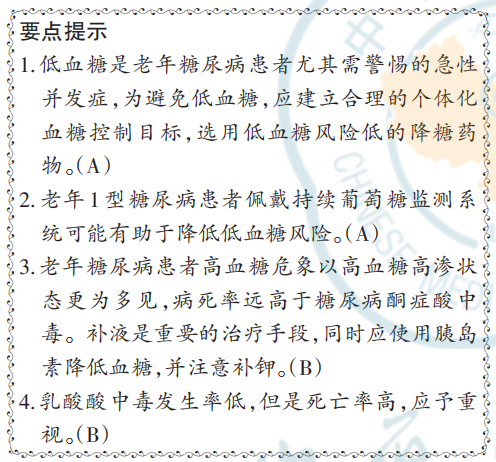
低血糖 、高血糖高渗状态(hyperglycemic hyperosmolar state,HHS)和糖尿病酮症酸中毒 (diabetic ketoacidosis,DKA)是糖尿病的严重急性并发症,需要迅速识别、及时诊断并积极治疗。低血糖是降糖治疗过程中的不良反应,可导致短期或长期不良临床结局并增加死亡率。老年糖尿病患者较非老年患者更易发生低血糖,低血糖导致的死亡风险也更高,临床医师应充分重视。DKA 和HHS 的特征是胰岛素缺乏和严重的高血糖,临床上,这两种情况仅在脱水程度和代谢性酸中毒的严重程度上有所不同。DKA或HHS患者的预后和结局取决于年龄、脱水的严重程度、合并症及治疗是否及时规范。老年糖尿病患者发生DKA和HHS的预后和结局通常较非老年糖尿病患者更差。
一、低血糖
在老年糖尿病患者中,低血糖是常见的急性并发症之一,可导致心律不齐、心肌梗死、跌倒,甚至昏迷、死亡等不良事件,反复发生严重低血糖会导致老年糖尿病患者的认知功能下降甚至痴呆[201] 。
1. 定义和标准:国内外指南目前推荐的低血糖定义和分级标准如下:接受药物治疗的糖尿病患者只要血糖<3.9 mmol/L 就属于低血糖。(1)1 级低血糖:血糖<3.9 mmol/L 且≥3.0 mmol/L;(2)2 级低血糖:血糖<3.0 mmol/L;(3)3 级低血糖:需要他人帮助治疗的严重事件,伴有意识和(或)躯体改变,但没有特定血糖界限[202] 。由于老年人群的异质性强,缺乏该人群的低血糖研究,且不同研究中低血糖的诊断标准尚未统一,我国缺乏大型的流行病学调查资料,目前我国老年糖尿病患者低血糖发生率情况不详。
2. 危险因素:年龄是低血糖发生的危险因素之一[203] ,老年糖尿病患者较非老年糖尿病患者的低血糖风险更高[204] 。除年龄因素以外,糖调节能力减弱、合并多种疾病(如 CKD、心血管疾病、肝功能不全等)、多重用药、合并自主神经病变等均是老年糖尿病患者发生低血糖的危险因素[205] 。老年糖尿病患者认知功能下降也是导致严重低血糖风险增加的重要原因[206] 。空腹饮酒、过度限制碳水化合物、进餐不规律、大量运动前未加餐等不良生活习惯是导致低血糖的常见诱因。
3. 临床表现:典型低血糖症状包括出汗、心慌、手抖等交感兴奋症状和脑功能受损症状。但老年糖尿病患者低血糖临床表现有极大的异质性,出现低血糖时常不表现为交感兴奋症状[207] ,而表现为头晕、视物模糊、意识障碍等脑功能受损症状,夜间低血糖可表现为睡眠质量下降、噩梦等。临床上对老年糖尿病患者的不典型低血糖症状应高度警惕。老年糖尿病患者由于神经反应性减弱,对低血糖的反应阈值下降,极易出现严重低血糖。无症状性低血糖发生风险较非老年糖尿病患者更高,而存在无症状性低血糖的老年糖尿病患者发生严重低血糖甚至死亡的风险高[208] 。反复发生低血糖可能进一步减弱神经反应性[209] ,患者甚至在不出现交感兴奋症状的情况下直接昏迷[210] ,如夜间发生上述情况,由于难以被发现和得到及时救治,极为凶险。
4. 预防和治疗:需要特别强调的是,胰岛素和促泌剂使用不当是糖尿病患者发生低血糖的重要原因[211] 。因此,胰岛素、磺脲类促泌剂、格列奈类促泌剂等低血糖风险较高的降糖药物需谨慎选用,使用时应加强血糖监测,必要时可应用 CGM 系统[212] 。单药应用二甲双胍、DPP‑4i、α‑糖苷酶抑制剂、GLP‑1RA、SGLT2i 等低血糖风险较低[213] ,但由于老年糖尿病患者常合并多种疾病,使用前述药物时仍应警惕与其他药物相互作用而导致的低血糖风险增加[214] 。低血糖风险增加与严格的血糖控制有关[215] ,因此,在老年糖尿病患者中针对患者个体情况设定合理的 HbA1c目标,对于减少低血糖发生至关重要。在设定个体化 HbA1c目标时,需仔细考量以下几个问题:糖尿病病程、患者的预期寿命、是否应用胰岛素和促泌剂、是否曾发生严重低血糖、是否合并存在其他情况(如共存疾病多、认知障碍、多重用药)等[216] 。老年T1DM患者的严重低血糖发生率高,尤其是长病程的患者[217] 。随机对照试验研究结果显示,佩戴 CGM 系统可能有助于降低老年T1DM患者低血糖发生风险[218] ,有条件的患者需要时可考虑使用。
二、高血糖危象
高血糖危象主要包括HHS和DKA。HHS是糖尿病的严重急性并发症之一,临床以严重高血糖、血浆渗透压升高、脱水和意识障碍为主要表现,通常无明显的酮症和代谢性酸中毒。老年糖尿病患者是HHS的最主要人群。HHS比DKA的病死率更高,约为 DKA 病死率的 10 倍[219],需引起临床医师的高度重视。感染是 HHS 的主要诱因,其次是胰岛素等降糖药物的不恰当停用,或患者存在心肌梗死、脑血管事件和创伤等其他伴随疾病[220] 。HHS起病隐匿,30%~40% 的 HHS 患者此前未诊断为糖尿病。HHS的临床表现包括高血糖症状、脱水症状以及神经系统症状,患者表现为烦渴、多饮、淡漠、嗜睡,甚至出现幻觉、癫痫样发作、昏迷等表现。由于老年人皮肤弹性较差,脱水的识别更加困难。HHS 的 诊 断 标 准 包 括 :血 浆 葡 萄 糖 水 平 ≥33.3 mmol/L,有效血浆渗透压≥320 mOsm/L,无明显的代谢性酸中毒和无严重酮症。治疗上,补液是至关重要的首要步骤,有助于恢复血容量和肾脏灌注、改善外周循环,并降低血糖水平。对于老年糖尿病患者,补液过慢过少更易出现低血压、肾前性肾功能不全,而补液过量过快则可能出现肺水肿、心功能不全。因此,补液速度需根据患者的血压、肾功能、心功能情况进行个体化调整。连续静脉注射胰岛素,积极补钾,并注意监测血钾,避免低钾血症导致恶性心律失常。
尽管老年糖尿病患者中的 DKA 并不常见,但一旦出现,老年糖尿病患者较非老年糖尿病患者更可能出现各种并发症、合并症,导致器官系统功能损害,最终导致不良结局[221] 。值得注意的是,DKA与 HHS并存并不少见。近年来随着免疫检查点抑制剂的使用,免疫检查点抑制剂使用后出现的糖尿病多以DKA起病[222] ,也可以同时合并HHS[223] 。因此,对于使用免疫检查点抑制剂的老年糖尿病患者应警惕 DKA 和 HHS。应用 SGLT2i的老年糖尿病患者也需警惕DKA发生的可能[224] 。腹痛、恶心、呕吐是 DKA 的常见临床表现,老年糖尿病患者出现DKA 时神经系统表现可能更为突出,而胃肠道表现不明显。诊断要点包括:血糖升高,血酮体和(或)尿酮体升高,血 pH 值和(或)二氧化碳结合力降低。无论是DKA还是HHS,或是两者并存,治疗均遵循下列原则:尽快补液恢复血容量、降低血糖、纠正电解质及酸碱失衡,同时积极寻找并去除诱因、防治并发症、降低病死率。
三、乳酸酸中毒
乳酸酸中毒罕有发生,但死亡率高,极其凶险。当糖尿病患者肾功能不全时,有可能造成双胍类药物在体内蓄积,增加乳酸酸中毒风险。肝肾功能不全的老年糖尿病患者应用双胍类药物时应警惕乳酸酸中毒。
第十二章 老年糖尿病的共患疾病
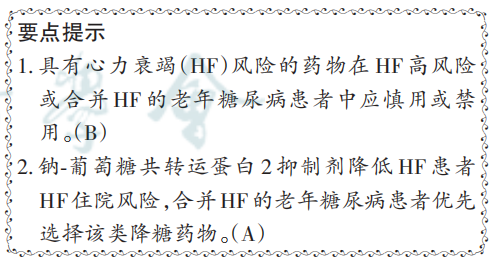
一、心力衰竭
年龄和糖尿病均是 HF 的危险因素,老年糖尿病患者中 HF 患病率高达 22.3%[225] ,近年来国外单中心研究显示,住院老年糖尿病 HF 患病率甚至高达 56%[226] 。由于老年糖尿病患者中射血分数保留的 HF 较常见,因此,老年糖尿病患者的 HF 易被漏诊。研究显示,老年糖尿病患者中 HF 漏诊率高达27.7%[227] 。HF与心血管死亡和住院风险独立相关[228]。尽管老年糖尿病中HF常见,但却缺乏制定最佳治疗策略所需的临床证据。胰岛素可能导致水钠潴留而加重HF,在合并HF的老年糖尿病患者中应慎用。美国纽约心脏病协会心功能Ⅲ级及以上的老年糖尿病患者禁用TZD 类降糖药 。 在SAVOR研究中,相较于安慰剂组,作为次要终点组分之一的HF住院率在沙格列汀治疗组中升高[229] ,合并 HF的老年糖尿病患者选择 DPP‑4i时,慎重选用沙格列汀。二甲双胍对糖尿病合并HF的患者安全有益[230‑231] ,如无禁忌证或不耐受,二甲双胍应保留在治疗方案中。SGLT2i能降低 HF住院风险,老年糖尿病人群与总体人群相似[73] 。合并HF的老年糖尿病患者,应优先选择该类药物[232] 。队列研究显示,相较于 DPP‑4i,GLP‑住院风险在内的复合终点[233 1 ] RA 也能改善包括 HF。
二、骨质疏松
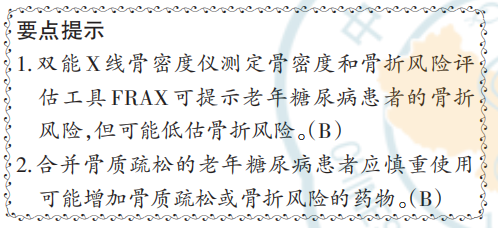
骨质疏松是一种与增龄相关的疾病,60 岁以上人群骨质疏松患病率明显增高,80 岁以上女性椎体骨折患病率可高达 36.6%[234]。糖尿病患者的骨折风险明显超过非糖尿病人群[235]。北京地区的数据显示,2016 至 2018 年糖尿病合并骨质疏松的患病率为13.4%~14.8%,老年糖尿病患者的骨质疏松患病率高于年轻糖尿病患者[236] 。因此,老年糖尿病患者是骨质疏松性骨折的高危人群,老年糖尿病患者一旦出现骨折,严重影响生活质量,致残率、致死率高。跌倒史、骨折史、握力低和HbA1c升高是老年 T2DM 患者骨折的危险因素[237] 。双能 X 线骨密度仪测定骨密度和骨折风险评估工具 FRAX 可用于评估糖尿病患者的骨折风险。但双能 X 线骨密度仪测得的骨密度会低估糖尿病患者的骨折风险,相同骨密度下,T2DM 较非糖尿病人群更易发生骨折[238] 。骨折风险评估工具 FRAX 也同样会低估糖尿病患者的骨折风险[239] 。应加强老年糖尿病患者骨质疏松防治知识的教育,积极进行骨折风险的评估,并早期干预。合并骨质疏松的老年糖尿病患者应慎重使用可能增加骨质疏松或骨折风险的降糖药物。Meta分析发现,老年T2DM患者使用磺脲类药物可能增加骨折风险,与其引发低血糖可能相关[240] 。中国专家共识建议,糖尿病合并骨质疏松的治疗参照非糖尿病患者[241] 。在骨质疏松药物选择上需考虑多病共存、多重用药等情况,全面评估、权衡利弊进行后个体化用药并进行监测。
三、肌少症与衰弱
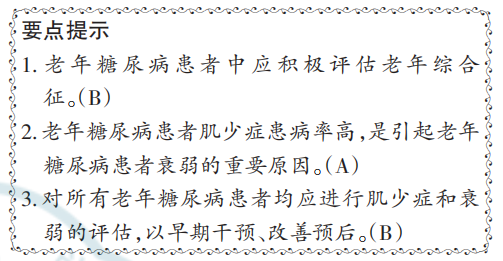
老年综合征是老年人中普遍存在的一种多种异常状态的群集,严重影响老年人的生活质量,导致不良的临床结局。亚太地区共识认为老年综合征应包含阿尔茨海默病、压疮、听力下降、视力下降、肌少症、衰弱和跌倒等[242] 。与非糖尿病老年人相比,老年糖尿病患者中老年综合征的患病率更高。
肌少症是一种增龄性疾病,中国老年糖尿病患者肌少症患病率14.8%[243] 。T2DM与肌肉力量下降和肌肉质量差有关,加剧了与年龄有关的肌少症[244] 。T1DM 患者也可出现肌少症[245] ,其发生机制与自身免疫性损害有关[246] 。合并肌少症的糖尿病患者糖代谢异常更加严重、营养状态更差,也更易合并骨质疏松、跌倒[247] 。肌少症使老年糖尿病患者的血糖更加难以控制,日常生活活动能力下降,并增加死亡率[248] 。因此,老年糖尿病中的肌少症问题应得到重视。由于增龄所带来的身体成分改变,老年糖尿病患者可同时出现肥胖和肌少症,即肌少性肥胖[249] 。肌少性肥胖的发生率随年龄增长而增加,在80岁以上的人群中,女性和男性分别达到 48.0% 和 27.5%[250] 。不应忽视肥胖的老年糖尿病患者中的肌少症,避免盲目减重,避免用药导致的体重过低。建议依据亚洲肌少症工作组的筛查与诊断标准在老年糖尿病患者中进行肌少症的评估[251] 。对于社区基层医疗机构,可以通过量表(简易五项评分问卷量表或简易五项评分问卷+小腿围量表)进行筛查,并对肌肉力量和躯体功能进行评估,考虑“肌少症可能”即进行生活方式干预。除上述筛查和评估的手段外,在医疗机构或临床研究中心还可以进一步通过测定四肢骨骼肌的含量来明确肌少症的诊断。
衰弱是指随着年龄的增长,机体退行性改变、生理储备功能下降以及多种慢性疾病引起的机体易损性增加,无法抵抗身体或心理应激,是一种残疾前状态。因此,与残疾、共病不同,导致衰弱的病因在一定程度上尚可逆转,早期识别并干预衰弱的老年人有助于改善预后。在老年人中,糖尿病使衰弱的风险增加 5 倍[252] ,导致患者活动能力下降、血糖监测和管理难度增加,影响患者的预后。Meta分析显示,社区患糖尿病的老年人中,衰弱和衰弱前期的患病率分别为 20.1% 和 49.1%[253] 。在制定血糖控制目标时,需考虑患者的虚弱程度,对于合并虚弱的老年糖尿病患者,可能需要简化、转换或降级治疗方案,尤其应考虑减少可能诱发低血糖的治疗,例如磺脲类药物和胰岛素[254] 。
关注老年糖尿病患者的肌少症和衰弱问题,对老年糖尿病患者进行肌少症和衰弱的评估,并给予适当干预有助于改善老年糖尿病患者的预后并减少医疗支出[255‑256] 。
四、跌倒
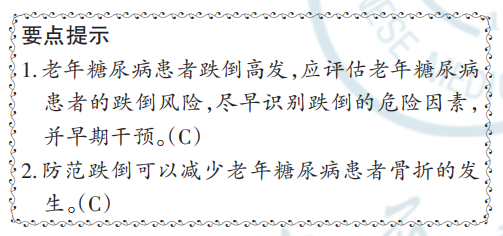
跌倒是我国老年人创伤性骨折、因伤致死的主要原因。随着年龄的增长,老年人的各项生理功能减退,包括维持肌肉骨骼运动系统功能减退造成的步态协调性下降、平衡能力降低,以及视觉、听觉、前庭功能、本体感觉下降,均增加了跌倒的风险。糖尿病增加老年人的跌倒风险,尤其是使用胰岛素的老年糖尿病患者,跌倒风险较非糖尿病老年人增加 94%[257] 。老年糖尿病患者跌倒虽然高发,但也是可以预防的。所有老年糖尿病患者都需要进行跌倒风险的评估,包括既往病史、躯体功能状态、环境、心理评估等。老年糖尿病患者跌倒的主要危险因素包括低血糖与血糖波动、中枢及外周神经病变、血管因素、体位性低血压、餐后低血压、糖尿病眼部病变、药物(降压药、利尿剂、镇静催眠药等)、肌少症与衰弱等。对于存在上述情况的老年糖尿病患者应积极干预,并寻求相关科室协助,以降低患者发生骨折和骨折相关并发症的风险。谨防合并骨质疏松的老年糖尿病患者跌倒。
五、认知障碍
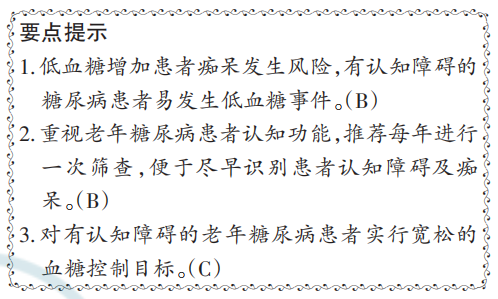
中国老年糖尿病患者中认知障碍的发生率为48%,在女性、年龄较大、教育水平较低、收入较低、无配偶和独居的人群中发生率更高[258] 。认知障碍与低血糖风险之间存在双向关系[259‑260] 。低血糖增加痴呆发生风险,包括血管性痴呆和阿尔茨海默病。另一方面,有认知障碍的糖尿病患者易发生低血糖。认知障碍使老年糖尿病患者很难执行复杂的自我管理任务[261] ,例如监测血糖和调整胰岛素剂量,也影响患者进食时间及用餐合理性。及早识别认知障碍对老年糖尿病管理具有重要意义。推荐老年糖尿病患者每年进行一次筛查,以便早期发现轻度认知障碍或痴呆。可选用简单易行的评估工具筛查认知障碍,如MMSE[262] 和MoCA[263] 。调整认知障碍的糖尿病患者的治疗方案,选用低血糖风险低的药物,同时尽可能简化治疗方案、“去强化治疗”,放宽血糖控制目标,避免低血糖和高血糖危象。二甲双胍和 GLP‑1RA 可能有助于改善认知功能。回顾性研究显示,老年 T2DM患者使用二甲双胍与痴呆风险降低显著相关,且呈现出剂量依赖效应[264] 。GLP‑1RA的使用与老年患者阿尔茨海默病发病率降低有关[265] 。磺脲类、TZD 类、DPP‑4i以及SGLT2i对认知功能的影响尚不明确[266] 。运动也有助于改善认知功能,一项随机临床试验发现太极拳比健身步行更有效地改善我国老年 T2DM 患者的认知功能[267] 。
六、精神疾病
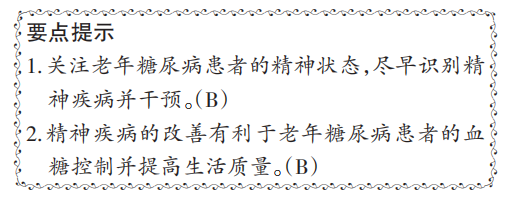
老年糖尿病患者发生抑郁的风险高于非糖尿病的老年人[268] ,但易被忽视。抑郁和焦虑情绪可能导致老年糖尿病患者依从性降低[269] ,血糖不易得到有效控制。应关注老年糖尿病患者的精神状态,尽早识别精神疾病并干预。可采用老年抑郁量表等简化筛查工具进行早期识别。建立和完善多学科团队协同照料模式,改善患者抑郁、焦虑症状,不但有助于提高生活质量,也有助于控制血糖。老年人群常出现谵妄[270] ,若老年糖尿病患者出现谵妄,应及时识别并去除诱因,积极鼓励家属参与非药物治疗的过程,提供护理支持,预防和治疗谵妄相关并发症。
七、低血压
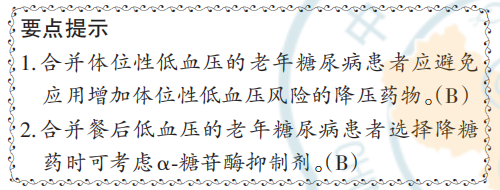
增龄导致心血管结构和功能发生改变,因此,老年人易出现体位性低血压和餐后低血压[271] 。低血压增加跌倒风险[272] ,甚至增加心血管事件和死亡的风险[273‑274] 。老年糖尿病患者体位性低血压风险较非糖尿病老年人更高,40%的体位性低血压患者合并糖尿病[275] 。合并高血压的老年糖尿病患者可同时存在体位性低血压,因此,该类患者应优先选择ARB类或钙通道阻滞剂[276‑277] ,避免坦索罗辛、卡维地洛等可能恶化体位性低血压的降压药物。在老年人中摄入碳水化合物含量高的热食和直立姿势均与症状性餐后低血压有关[278] 。在老年糖尿病患者中应关注头晕、晕厥等症状与进食和体位变化的关系。调整生活方式可能有助于减少老年糖尿病患者症状性低血压的发生。此外,α‑糖苷酶抑制剂有助于改善老年糖尿病患者的餐后低血压 症 状[50,279],选 用 降 糖 药 物 时 可 予 以 考 虑 。SGLT2i 有轻度降低血压的作用,应关注应用该类降糖药物患者的血压。
八、肿瘤
糖尿病患者肿瘤风险增加,包括肝细胞癌、肝胆管癌、胰腺癌、乳腺癌、卵巢癌、子宫内膜癌和胃肠道恶性肿瘤等多种癌症[280‑281] 。建议老年糖尿病患者接受与其年龄和性别匹配的肿瘤筛查。血糖升高有时是胰腺癌的首发临床表现[17] ,新发老年糖尿病患者应筛查排除胰腺癌可能。部分降糖药可DPP‑4i [283] 等。
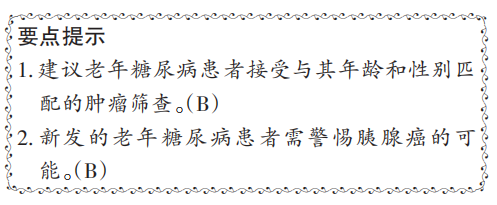
九、阻塞性睡眠呼吸暂停综合征
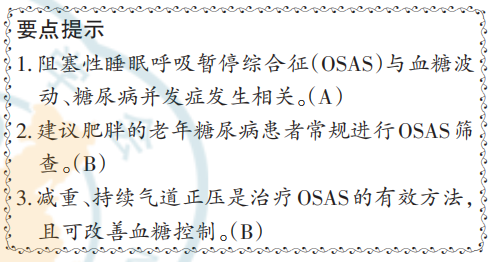
阻塞性睡眠呼吸暂停综合征(obstructive sleepapnea syndrome,OSAS)是常见的睡眠障碍类型之一,属于片段化睡眠,是导致糖代谢异常、继发性高血压及多器官损害的睡眠呼吸疾病。OSAS导致多种应激激素分泌增加、血糖波动加剧、血糖控制的难度增加。OSAS 的患病率随着年龄增长而增加[284] ,肥胖也是OSAS的重要危险因素。合并糖尿病者 OSAS 常更严重[285] ,OSAS也与糖尿病并发症的发生和进展密切相关。男性OSAS的发生率高于女性,绝经后女性 OSAS 发生率明显高于绝经前女性。建议老年糖尿病患者,尤其是肥胖者进行OSAS筛查。
对合并 OSAS 的老年糖尿病患者,应积极进行生活方式干预减重、戒烟、限酒,避免浓茶和咖啡以及日间过度劳累和兴奋而影响睡眠[286] 。持续气道正压是治疗 OSAS 的有效方法,可显著改善糖尿病患者血糖水平及胰岛素抵抗[287‑288] 。避免选用导致体重增加的药物,严重低氧血症的患者应慎用或禁用双胍类药物。此外,需注意排查并治疗引起或加重 OSAS 的基础疾病,如甲状腺功能减退等[289] 。
十、睡眠障碍
除 OSAS 外,老年糖尿病患者还可能存在多种形式的睡眠障碍。本节内容讨论非OSAS所致的睡眠障碍。老年人存在脑功能生理性退化、易出现焦虑情绪、心理承受能力较弱等特点,是睡眠障碍的高发人群[290] 。糖尿病患者夜尿增多、痛性神经病变、躯体症状和精神障碍等均可能导致睡眠障碍。老年糖尿病患者睡眠障碍发生风险高,影响血糖控制和生活质量,应予以关注。对存在睡眠障碍的老年糖尿病患者积极进行健康教育与干预,有助于提高睡眠及生活质量,同时改善血糖[291] 。

十一、口腔疾病
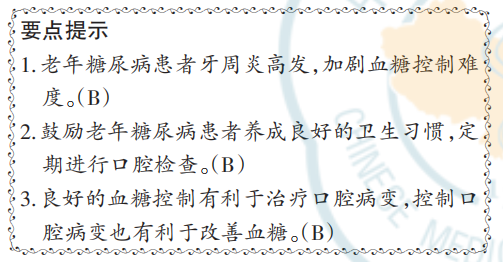
随着年龄的增长,口腔疾病的风险增加。口干、口腔运动功能下降、口腔卫生管理能力下降等多种原因均可导致老年人出现口腔疾病。糖尿病患者口腔疾病的患病率、病程和严重程度均较非糖尿病人群明显增加[292] 。牙周炎是糖尿病的常见合并症之一,糖尿病是牙周炎的重要危险因素,糖尿病患者与非糖尿病人群相比,牙周炎的发生风险增加近3倍。与非老年糖尿病患者相比,老年患者面临更普遍、更严重的口腔问题,如龋齿、口腔干燥症、牙周疾病等。良好的血糖控制有利于患者牙周炎等口腔病变的治疗,而针对牙周炎等口腔病变的治疗有利于改善血糖的控制[293‑295] 。鼓励老年糖尿病患者养成良好的卫生习惯,坚持每天有效刷牙,去除牙石、食物嵌顿等局部刺激因素,保持口腔环境清洁,定期进行口腔检查和牙周洁治。
十二、皮肤病变
糖尿病患者可以出现多种皮肤病变,包括:
(1)皮肤感染:细菌、真菌或病毒感染;
(2)与糖尿病
(3)糖尿病慢性并发症的皮肤表现:如糖尿病足所致皮肤溃疡,甚至坏疽;(4)糖尿病治疗所致皮肤改变:如注射胰岛素后所致皮下脂肪增生、皮下脂肪减少等。皮肤瘙痒是糖尿病患者常见症状,12.7% 的T2DM 患者出现皮肤瘙痒,合并糖尿病周围神经病变的T2DM中皮肤瘙痒发生率更高(20.5%)[296] 。高龄、长病程也是糖尿病患者皮肤瘙痒的危险因素[297] ,因此,老年糖尿病患者皮肤瘙痒发生率高,皮肤瘙痒严重影响老年糖尿病患者的生活质量。减少洗澡次数和涂抹润肤霜可以改善皮肤干燥,可能有助于缓解皮肤瘙痒。糖尿病患者血糖控制不佳可导致皮肤病变风险增加,皮肤感染等皮肤病变也可导致血糖升高。内分泌专科医师应关注老年糖尿病患者的皮肤情况,进行积极的处理,必要时转诊至皮肤专科进一步诊治。直接相关的皮肤病:糖尿病性大疱、黑棘皮病等;
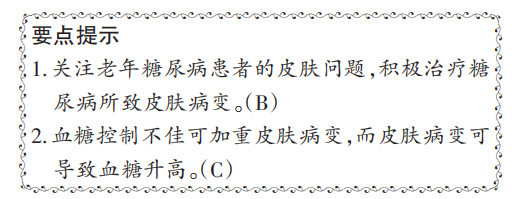
第十三章 老年糖尿病的多重用药
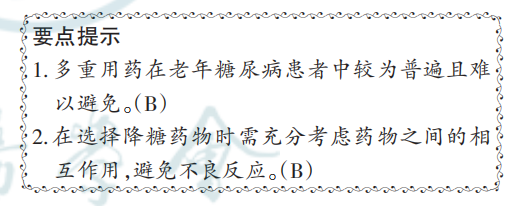
多重用药是指患者同时使用≥5种药物。老年糖尿病患者多合并高血压、冠心病、脑卒中及慢性呼吸系统疾病等,多重用药在老年糖尿病患者中较为普遍且难以避免。多重用药会增加药物相互作用的风险,不仅可能影响老年糖尿病患者的降糖疗效,还可能增加低血糖风险。磺脲类药物主要经肝脏 CYP2C9 酶代谢,老年患者合用氟康唑、西咪替丁等 CYP2C9 抑制剂时,会减慢磺脲类药物代谢,增加低血糖风险。阿卡波糖与华法林合用会使凝血酶原国际标准化比值升高,增加出血风险,需要及时调整剂量。瑞格列奈主要通过 CYP2C8 和CYP3A4酶代谢,与氯吡格雷、酮康唑、ACEI及单胺氧化酶抑制剂等药物合用时,可能增强和(或)延长瑞格列奈的降糖作用,增加低血糖风险。沙格列汀经 CYP3A4 代谢,与酮康唑、伊曲康唑、阿扎那韦、利托那韦、克拉霉素和泰利霉素等 CYP3A4的强抑制剂合用时,显著升高血药浓度,应减量使用;而与卡马西平合用会加快其代谢,显著降低降糖效果[298] ;维格列汀与肿风险[299] 。罗格列酮 ACEI 、吡格列酮经 合用会增加血管神经性水CYP2C8 代谢,吉非罗齐、氯吡格雷减缓其代谢,升高血药浓度[300] ;CYP2C8 诱导剂利福平等加快其代谢,降低降糖疗效。因此,在制定药物治疗方案时需考虑老年患者的药物使用情况,对于多重用药的患者,尽可能选择药物相互作用较少的降糖药物,避免不良的药物‑药物相互作用。
第十四章 老年糖尿病的特殊情况
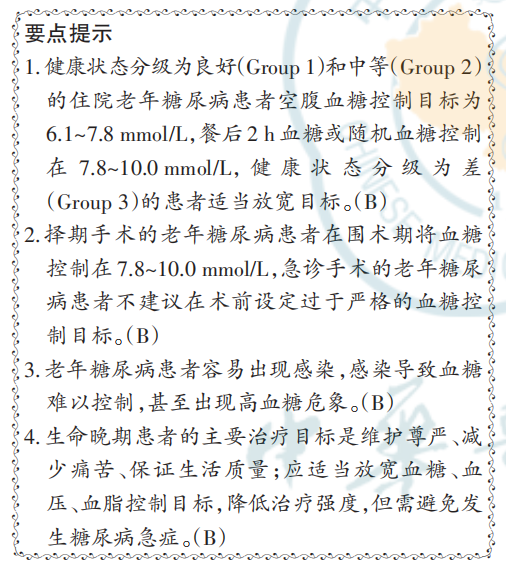
一、老年糖尿病的医院管理
老年糖尿病患者常因各种非糖尿病相关的问题住院,如心血管疾病、呼吸困难、感染等,内分泌科医师需与其他专科医师进行团队合作对患者的血糖进行管理。住院患者的情况可能会在短时间发生变化,要求医师及时识别并调整治疗方案。应用糖皮质激素治疗、鼻饲、全肠外营养、透析等可能引起患者血糖变化的情况出现时,应及时再次评估降糖方案。临床医师应该始终将患者的年龄、预期寿命、整体的健康状态、功能状态、认知能力等纳入考量,在血糖控制与不良反应之间权衡。患者在非内分泌科专科住院期间,制定清晰的血糖控制目标有利于血糖管理[301] 。参照《中国住院患者血糖管理专家共识》的建议[302],健康状态分级为良好(Group 1)和中等(Group 2)的住院老年糖尿病患者采取一般的血糖控制目标:空腹血糖控制在 6.1~8mmol/L,餐后2 h血糖或随机血糖控制在7.8~10.0mmol/L,可根据患者的个体情况,对于低血糖风险高、预期寿命短、健康状态分级为差(Group 3)的老年糖尿病患者,适当放宽目标至空腹血糖7.8~10.0 mmol/L,餐 后 2 h 血 糖 或 随 机 血 糖 7.8~13.9 mmol/L,同时应避免高血糖危象发生。
二、老年糖尿病的养老机构管理
随着我国老龄化社会进程加快,养老机构老年糖尿病患者的健康管理越来越重要。对有专业医护人员的养老机构,可参照前述老年糖尿病的医院管理进行处理。但目前我国养老机构主要提供基本生活照料,缺少糖尿病等慢性疾病的健康管理服务,应加强对照护人员的糖尿病教育[136] 。过于严格的饮食控制对老年糖尿病患者血糖控制获益有限[303] ,还可能增加其发生营养不良的风险。在设定血糖管理目标时,充分考虑老年人并发症及合并症情况、功能状态及预期寿命[304] ,根据不同的组别、血糖控制及并发症情况等情况制定相应的饮食、运动方案。目前养老机构常用血糖仪进行指尖血糖监测,有条件的养老机构可根据需要检测HbA1c 和进行持续葡萄糖监测(continuous glucose monitoring,CGM)。对于使用磺脲类药物或胰岛素治疗的老年患者,可根据需要使用 CGM 评估低血糖风险[136] 。需及时识别老年患者糖尿病急性并发症 ,如 怀 疑 DKA 和 HHS 应紧急处理后立即转诊[304] 。应注意老年糖尿病患者的足保护,一旦出现足部皮肤破溃,应及时将患者转诊到代谢内分泌专科或糖尿病足病相关科室。
三、老年糖尿病的居家管理
居家老年人中糖尿病患病率高[305] ,糖尿病是居家老年人需重点关注的慢病之一。老年糖尿病患者的居家管理应包括居家老年人自身对健康的管理、家庭成员对居家老年人的照护以及社区医疗机构对居家老年人进行的慢病管理。多学科团队干预模式可改善居家老年糖尿病患者的血糖和心态,并能够在一定程度上提高患者的自我管理能力[306] 。老年糖尿病患者居家管理应注意预防低血糖、高血糖危象以及跌倒等急性事件。
四、围术期管理
老年糖尿病患者围术期血糖控制目标为 7.8~10.0 mmol/L[108,307] 。对于有严重合并症和频繁低血糖 发 作 的 老 年 患 者 ,控 制 目 标 最 高 可 为13.9 mmol/L[307] 。对于拟行心脏手术或其他精细手术的患者,在权衡低血糖风险的基础上,建议可考虑 更 为 严 格 的 血 糖 控 制 目 标 ,即 6.1~7.8 mmol/L[308] 。为尽量减少血糖对患者及手术的影响,糖尿病患者首选在清晨或尽早手术,手术时间较晚的患者需在病房持续监测血糖[309] 。手术需要禁食,于手术当日早上停用所有口服降糖药物,在禁食期间,每 4~6 小时进行一次血糖监测,术中根据情况增加血糖监测频次,如血糖水平超过控制目标给予短效人胰岛素或速效胰岛素类似物。对于接受小手术的患者,若仅应用口服降糖药血糖即可控制良好,则术中无需应用胰岛素,并在术后恢复其口服降糖药。空腹期间注意停用低血糖风险高的药物,手术时应暂停使用 SGLT2i 以避免 DKA风险[309] 。对接受大、中手术的患者,尤其是血糖控制不佳的患者,应及时改为胰岛素治疗,术中应继续应用胰岛素,并密切监测血糖。术后患者恢复正常饮食前可胰岛素静脉输注控制血糖,恢复正常饮食后改为胰岛素皮下注射。拟行急诊手术的患者不建议在术前设定过于严格的血糖控制目标,而应尽快进行术前准备,采用胰岛素静脉输注的方式降低血糖,并在术中加强监测血糖。围术期应关注血糖变化,警惕低血糖发生。
五、感染与疫苗接种
糖尿病患者易并发细菌、真菌、病毒以及非典型致病菌感染,常见的感染部位包括呼吸道、泌尿系统、皮肤和软组织等。与一般人群相比,T2DM患者感染预后更差,其败血症的发病率和死亡率更高[310] 。糖尿病患者比非糖尿病患者有更高的皮肤和软组织感染的风险,但同时合并严重糖尿病神经病变和血管病变的患者不会表现出典型的软组织感染症状[311] 。老年糖尿病患者感染风险较高,且不易控制[312] 。一项回顾性队列研究显示,相较于40~49 岁的糖尿病患者,80~89 岁患者住院风险高3~4倍,其中与感染有关的住院比例很高[313] 。病程长、血糖控制不佳的老年患者并发感染将导致血糖更加难以控制,甚至诱发高血糖危象。
新型冠状病毒感染(corona virus disease 2019,COVID‑19)与已知糖尿病患者和此前未诊断的糖尿病患者的高血糖有关。武汉一项针对住院患者(主要是老年 COVID‑19)的研究显示,21.6% 的患者有糖尿病病史,根据入院时的首次血糖测量,20.8%新诊断为糖尿病,28.4%新诊断为血糖异常。糖尿病患者入院时的血糖水平与全因死亡风险增加有关。新诊断的糖尿病患者更可能进入重症监护病房,并需要有创机械通气,急性呼吸窘迫综合征、急性肾损伤 或 休 克 的 患 病 率 高 ,住 院 时 间 最 长[314] 。COVID‑19患者新发糖尿病的确切机制尚不明确,可能的原因包括:既往未诊断的糖尿病、应激性高血糖、病毒感染或类固醇相关糖尿病[315] 。肥胖、高血糖以及心血管和肾脏疾病是COVID‑19患者预后不良的危险因素,因此,对于急性COVID‑19感染和持续症状(即长新冠)后糖尿病患者的长期管理,推荐使用不增加体重且改善心肾结局的降糖药物(如SGLT2 和 GLP‑1RA),但 是 尚 无 长 期 随 访 的证据[315 ] 。良好的血糖控制、加强自身卫生、进行必要的免疫接种在一定程度上可预防严重的感染性疾病。老年糖尿病患者应根据情况进行流感、肺炎链球菌等疫苗接种,以减少住院和死亡风险,但流感疫苗接种中需要注意避免接种减毒活疫苗[316] 。对于合并感染的老年糖尿病患者,严格控制血糖是首要措施,但对共存疾病多、预期寿命短的患者可适当放宽血糖目标,同时需进行有效的抗感染治疗,必要时行外科手术治疗。
六、舒缓医疗
当老年糖尿病患者进入生命的晚期时应进行不同于其他时期的特殊管理。在这一阶段,维护患者的尊严、减少痛苦和保证生活质量尤为重要。患者有权拒绝检查和治疗,医护人员应考虑减少诊断性检查及不必要的治疗,尽可能使医护人员、患者、家属共同参与医疗决策过程。这一阶段的主要目标并非严格的血糖、血压、血脂管理,采取姑息治疗,减少血糖监测的频率,预防低血糖和高血糖危象,解除患者疼痛等不适症状,有助于提高患者的生活质量。在降糖方案的选择上,可以将口服降糖药物作为一线药物,但不建议使用胃肠道不良反应发生风险高的药物,必要时可给予基础胰岛素。有器官损害的 T2DM 患者应减量使用低血糖风险高的药物,允许血糖处于正常高限或不出现急性代谢异常的可接受范围,根据进食量必要时可停用药物治疗。对于器官衰竭的患者,T1DM 患者胰岛素用量可随着进食量的减少而减少,但不应停用。对于临终状态的 T1DM的治疗方案尚无定论,可以通过小剂量基础胰岛素预防高血糖急性并发症[136] 。
第十五章 老年1型糖尿病及相关问题
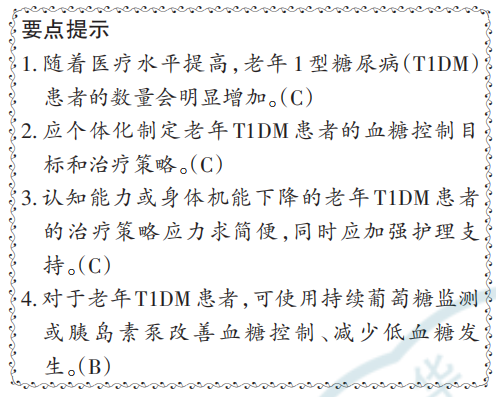
老年 T1DM 患者是指年龄≥65岁,包括 65岁以前诊断和 65 岁及以后诊断的 T1DM 患者。随着生活和医疗水平的提高,T1DM 患者的寿命延长,老年T1DM患者的数量会明显增加。老年T1DM患病率较低,但老年期LADA并不少见。与年轻起病的患者相比,老年起病的 LADA 患者残余的胰岛 β细胞功能相对较好,胰岛素抵抗更显著,代谢综合征的特征更明显。老年起病的 LADA 患者中胰岛自身抗体阳性的比例和年轻起病的 LADA 相似,但HLA‑DQ 遗 传 背 景 与 年 轻 起 病 的 LADA 有 显 著差异[317] 。
与老年 T2DM 的管理相似,需结合患者的年龄、预期寿命、功能状态、基础疾病以及并发症情况等确定血糖控制目标以及降糖方案。老年 T1DM患者血糖管理难度大,高血糖危象和低血糖风险均较老年T2DM患者更高。在老年T1DM患者出现微血管或大血管并发症之前,可以考虑较为严格的血糖控制目标,但需权衡低血糖风险。长病程是老年T1DM患者发生低血糖的危险因素,病程超过40年的 老 年 T1DM 患 者 中 严 重 低 血 糖 发 生 率 达18.6%[217] ,应适当放宽患者血糖控制目标。
近年来,糖尿病管理相关技术在胰岛素注射和血糖监测领域取得了较大的进展。在针对老年T1DM患者进行的研究中,使用CGM或胰岛素泵的患者HbA1c水平更低,少[318] 。WISDM 随机临床试验显示 低血糖事件和血糖波动较,与指尖血糖监测相比,老年T1DM患者使用CGM可减少低血糖发生,改善总体血糖控制[319] 。此外,研究也证实了混合闭环胰岛素泵在老年 T1DM患者中的安全性,与实时动态胰岛素泵组比较,混合闭环胰岛素泵组患者的 TIR 更高、TBR 更低[320] 。需要注意的是,前述的临床试验中少有纳入70岁及以上的老年人群。
由于疾病管理的复杂性,老年 TIDM 的自我管理过程依赖于患者良好的认知能力。有严重低血糖的老年 T1DM患者更容易出现认知功能下降,应简化胰岛素治疗方案。TIDM可能导致老年人的身体机能下降,随着身体机能的下降,老年 T1DM 患者的自我管理能力下降,应加强护理支持。对于丧失独立生活能力的老年 TIDM 患者,需护理人员协助患者进食、活动以及注射胰岛素。关于老年 T1DM 患者中血压、血脂、蛋白尿管理的循证医学证据均较缺乏。临床医师应该根据每个患者的个体情况确定治疗目标及策略。
未完待续……
